Elevating Your Essay with Vivid Language: Techniques for Effective Expression

Essay writing is not just about conveying information; it's about capturing the reader's imagination and engaging their senses. One of the most powerful tools at your disposal for achieving this is vivid language. Vivid language paints a picture, evokes emotions, and brings your writing to life. In this guide, we'll explore the techniques you can use to elevate your essays with vivid language and make your writing truly stand out.

Understanding the Power of Vivid Language
In the world of essay writing, vivid language is like the artist's palette, allowing you to create vibrant and captivating images with words. Whether you're describing a scene, conveying emotions, or building an argument, vivid language adds depth and richness to your writing. It helps you connect with your readers on a deeper level, making your essays more memorable and impactful.
Techniques for Incorporating Vivid Language in Your Essays
1. using descriptive adjectives and adverbs.
When it comes to painting a vivid picture with words, adjectives and adverbs are your best friends. Instead of using generic terms, opt for specific and evocative descriptors that appeal to the senses. For example, instead of saying "the tree was big," you could say "the towering oak stretched its branches towards the sky."
2. Employing Sensory Details
The key to creating immersive writing is to engage the reader's senses. Describe sights, sounds, smells, tastes, and textures to bring your scenes and experiences to life. By appealing to the five senses, you create a multi-dimensional experience for your readers that makes your writing more vivid and memorable.
3. Utilizing Figurative Language
Figurative language, such as similes, metaphors, and personification, adds layers of meaning and depth to your writing. By comparing one thing to another or giving human qualities to inanimate objects, you create vivid and imaginative images that resonate with your readers. However, it's important to use figurative language judiciously and avoid clichés to keep your writing fresh and original.
4. Crafting Vivid Dialogue
Dialogue is a powerful tool for adding authenticity and dynamism to your essays. Use dialogue to reveal character traits, advance the plot, and create tension and conflict. Pay attention to the nuances of speech, such as tone, rhythm, and diction, to make your dialogue sound natural and engaging.
Practicing and Polishing Your Writing
1. engaging in freewriting and brainstorming.
To unleash your creativity and generate vivid language ideas, try freewriting and brainstorming. Set aside judgment and allow your ideas to flow freely onto the page. Experiment with different words, phrases, and images to see what resonates with you.
2. Revising and Editing for Vividness
In the revision process, focus on refining and strengthening your use of vivid language. Look for opportunities to replace weak or generic language with more specific and evocative alternatives. Use a checklist to evaluate the effectiveness of your vivid language and make adjustments as needed.
3. Seeking Feedback and Improvement
Don't be afraid to seek feedback from peers, teachers, or writing mentors. Their insights can help you identify areas for improvement and refine your vivid language skills. Embrace constructive criticism and use it as an opportunity to grow and develop as a writer.
Incorporating vivid language into your essays is like adding color to a black-and-white photograph – it brings your writing to life and makes it more vibrant and compelling. By mastering the techniques outlined in this guide and practicing regularly, you can elevate your essay writing to new heights and leave a lasting impression on your readers. So go ahead, unleash your creativity, and let your words paint a vivid masterpiece on the canvas of your essays.
- ESSAY EXAMPLES (17)
- ESSAY TIPS (48)
- ESSAY TOPICS (1)
- 2024 March (9)
- 2024 February (7)
- 2024 January (7)
- 2023 December (5)
- 2023 November (4)
- 2022 March (2)
- 2022 January (1)
- 2019 January (1)
- 2018 December (1)
- 2018 November (1)
- 2018 October (1)
- 2018 August (2)
- 2018 July (2)
- 2018 June (2)
- 2018 April (18)
- 2018 March (3)
Popular posts

Choosing a Topics to Write about in Argumentative Essay
26 April, 2018

Perceptions of Young Fathers Regarding Fatherhood
19 November, 2018

THE HISTORY OF NEW YORK CITY
27 April, 2018

Human Resource
24 December, 2018

Ethics of Abortion
Jun 27, 2023
Descriptive Essay Examples: Bring Your Writing to Life with Vivid Descriptions and Engaging Language
Dive into the vibrant world of descriptive writing! Discover how to captivate your audience with rich details and stirring language, creating immersive experiences with your words!
Immerse yourself in the vibrant art of descriptive writing in this comprehensive guide. Throughout this article, we'll explore the intricacies of crafting descriptive essays, offering you useful tips, and showcasing compelling examples.
You'll learn the essence of sensory details in creating vivid imagery, the structure of a captivating essay, and pointers for picking engaging topics. Our journey will feature rich examples like a description of the Grand Canyon, demystifying the language techniques used.
So, are you ready to amplify your writing skills and charm your readers with words? Dive right into the world of descriptive essays and let your creativity flow!
Understanding Descriptive Essays
Before we delve into crafting engaging descriptive essays, let's clarify their fundamental purpose. Each essay type serves a unique role, and for descriptive essays, the objective is to paint an elaborate picture using vivid language and sensory details. As a writer, your goal is to transport readers to a particular location, event, or time, allowing them to experience it through their senses.
Among different essay types, each comes with a specific objective. Let's consider a few:
Narrative Essays: These essays recount a story or event. Your goal here is to craft a captivating narrative that keeps your reader engrossed from beginning to end.
Descriptive Essays: The focus of a descriptive essay is to create a vivid mental image for your reader. By using intricate details and expressive language, you invite readers into a sensory experience, making them feel as if they're part of the story.
Expository Essays: In an expository essay, the aim is to clarify or inform. You should present information in a clear, concise manner, educating your reader about a particular topic or issue.
Persuasive Essays: Persuasive essays aim to convince the reader to adopt a certain viewpoint or perform a specific action. Your task here is to utilize evidence and logical reasoning to support your argument, persuading your reader to agree with your stance.
In the context of creative writing, which includes forms like short stories, poetry, novels, and memoirs, descriptive writing serves as an essential tool. Through the use of metaphors, vivid descriptions, and other literary devices, writers can create a powerful impact and engage readers in an imaginative experience.
Whether you are aiming for fiction or non-fiction, creative writing offers a platform to explore your creativity, express your thoughts, ideas, and experiences in an original and unique way. It invites experimentation with styles, genres, and techniques, allowing for the creation of unique literary pieces.
Improving creative writing skills is an ongoing journey, with numerous resources available, including online courses and writing workshops. So, embark on your creative journey, explore your imagination, and unlock your creative potential!
In conclusion, understanding an essay's objective is a crucial step towards successful writing. A clear definition of the essay's purpose guides you to develop a robust thesis statement and structure your arguments effectively, making your essay a compelling read.
The Framework of a Descriptive Essay
Descriptive essays breathe life into words by painting a vivid picture of a person, place, thing, or experience. They employ sensory details and expressive language to make the subject come alive for the reader. Here's a basic yet effective structure you might use when crafting a descriptive essay:
1. Introduction
Your introduction should pique the reader's interest and provide some context for your essay's subject. Begin with an engaging statement about your subject, an intriguing rhetorical question, or an interesting fact to hook your audience. Subsequently, introduce your thesis statement, a clear declaration of the particular aspect or impression of the subject you will be describing.
2. Body Paragraphs
The body of your essay should dive into a detailed description of your subject. Each paragraph should spotlight a unique facet of your subject, using sensory details to paint a vibrant image for the reader. Language techniques such as metaphors, similes, and personification can enhance your descriptions. Depending on your subject and its characteristics, you may want to organize your paragraphs in chronological or spatial order.
3. Conclusion
The conclusion should encapsulate the key points of your essay, leaving a lasting impression on your reader. Restate your thesis statement and offer a brief summary of your main points. Conclude with a striking statement or image that underscores your essay's primary theme.
Bear in mind that this structural blueprint for a descriptive essay is flexible and may require adjustments based on the specific topic or purpose of your essay. Still, this basic outline provides a robust foundation to organize your thoughts and guide your journey in crafting a compelling descriptive essay.
Expanding Your Imagination: Descriptive Essay Writing Inspiration Ideas
Crafting a remarkable descriptive essay involves bringing a scene to life with your words. This immersive style of writing can be applied to a variety of topics. Here are some areas you might want to explore:
1. Recalling Cherished Memories
Our minds are vaults of experiences just waiting to be unraveled. Dive into your childhood memories and bring forth a moment that left an indelible mark on you. Remember to describe the environment, your emotions, people around you, and why this memory has remained so vivid over the years.
2. Exploring Unfamiliar Territories
Have you always dreamt about a certain place but never had the chance to visit? This is your opportunity to transport your readers to this location using your imagination. Research, craft an image, and explore this place in your mind, then share it with your audience.
3. The Magic of the Seasons
Every season carries its unique charm. Pick your favorite season and describe its essence. Use sensory details to communicate the change in the atmosphere, the transformation in the landscape, and how these alterations make you feel.
4. Delving into Personal Relationships
Consider a person who has made a significant impact on your life. It could be a family member, a friend, or even a celebrity. Describe them and explain why they are so influential. Discuss their characteristics, their words, actions, or ideas that have inspired you.
5. Relishing in the Gastronomic Delights
Food can elicit powerful memories and emotions. Describe your favorite dish or a memorable meal in great detail. Use descriptive language to convey its flavors, textures, and aromas, and share why it holds a special place in your heart.
6. Reimagining Historical Events
Historical events offer rich ground for descriptive essays. Choose an event that interests you and imagine you're a part of it. Describe the environment, the people, their emotions, and the atmosphere during this event.
Remember, the key to writing a compelling descriptive essay is to paint a vibrant picture using your words. By carefully selecting your subject and using detailed, sensory language, you can create a narrative that captivates your readers and provides them an experience to remember. Be creative, have fun with your writing, and let your imagination roam free.
Descriptive Essay Examples
Example essay 1: "my favorite place" .
My favorite place in the world is my grandparents' farm in the countryside. As I walk down the dirt road that leads to the farmhouse, I am greeted by the sweet smell of hay and the sound of crickets chirping in the distance. The rolling hills that surround the farm are covered in lush green grass and dotted with wildflowers of every color. The old wooden barn and weathered farmhouse are a testament to the many years of hard work and love that my grandparents have put into this land. I can't help but feel a sense of peace and belonging when I am here, surrounded by the beauty of nature and the memories of my family.
Example Essay 2: "The Haunted House"
As I stepped through the creaky gate and onto the overgrown path that led to the abandoned mansion, I felt a chill run down my spine. The house's ivy-covered walls and broken windows loomed over me like a giant beast waiting to pounce. The air was thick with the scent of decay and mold, and the sound of rustling leaves and distant whispers made me feel as if I was not alone. As I explored the dark and eerie interior of the house, I couldn't help but feel as if I was stepping into a nightmare. The peeling wallpaper and rotting floorboards added to the sense of dread, and the only light came from the occasional flash of lightning that illuminated the shadows. I left the haunted house feeling as if I had been transported to another world, a world of darkness and fear.
Example Essay 3: "A Day at the Beach"
The sun was blazing down on the white sand and turquoise waters of the beach as I settled onto my towel and let the warm breeze wash over me. The sound of crashing waves and seagulls filled the air, and the salty smell of the ocean mingled with the sweet scent of coconut oil and sunscreen. The water was crystal clear, and I could see schools of brightly colored fish darting in and out of the waves. As the day wore on, I built sandcastles with my nieces and nephews, went for a swim in the cool water, and soaked up the sun until my skin was golden brown. As the sun began to set and the sky turned fiery orange and pink, I knew that this was a day I would never forget.
Example Essay 4: "The City at Night"
The city comes alive at night, its streets bathed in the glow of neon lights and the hum of activity. The air is filled with the scent of roasted peanuts and hot dogs, and the sound of honking horns and chatter of people fills your ears. The towering skyscrapers loom above you, casting long shadows that stretch across the sidewalks. The city never sleeps, and you feel alive in its energy and vibrancy.
Example Essay 5: "My First Love"
The moment I laid eyes on her, I knew I was in love. Her eyes were like pools of emerald green, and her smile was like sunshine on a cloudy day. Her voice was soft and musical, and I could listen to her talk for hours. We spent every moment we could together, exploring the city, watching movies, and talking about everything and nothing at all. Even now, years later, I can still feel the warmth of her hand in mine and the thrill of our first kiss.
Example Essay 6: "A Winter Wonderland"
As I stepped outside into the winter wonderland, I was struck by the beauty of the snow-covered landscape. The trees were draped in a blanket of white, and the snow sparkled like diamonds in the sunlight. The air was cold and crisp, and my breath formed puffs of steam as I exhaled. I bundled up in my warmest coat and gloves and set out to explore the snowy wonderland, feeling like a child again.
Example Essay 7: "The Perfect Day"
The perfect day for me is one where the sun is shining, the birds are singing, and the world is filled with endless possibilities. I wake up early and savor a cup of hot coffee as I watch the sunrise from my front porch. Then, I spend the day exploring the great outdoors, hiking in the mountains, swimming in a crystal-clear lake, and soaking up the beauty of nature. In the evening, I enjoy a delicious meal with my loved ones, and we laugh and share stories until the stars come out.
Example Essay 8: "A Magical Place"
As I stepped through the door of the tiny bookstore, I felt as if I had been transported to a magical world. The shelves were lined with books of every size and color, and the air was thick with the scent of old paper and ink. The cozy armchairs and crackling fireplace invited me to curl up with a good book and get lost in a story. I spent hours exploring the aisles and discovering hidden treasures, feeling as if I had found a secret portal to another world.
Example Essay 9: "The Taste of Home"
The taste of my grandmother's cooking is something that will always hold a special place in my heart. Her homemade apple pie was the perfect combination of sweet and tangy, with a buttery crust that melted in my mouth. Her hearty beef stew warmed my soul on cold winter nights, and her homemade bread was the perfect accompaniment to any meal. Every bite was infused with love and care, and I can still taste the flavors of my childhood in every dish she made.
Example Essay 10: "The Seashore"
As I walked along the sandy shore, the sound of crashing waves filled my ears and the salty ocean air tickled my nose. The sun beat down on my skin, warming me from the inside out. I closed my eyes and listened to the seagulls calling overhead and the laughter of children playing in the distance. The water lapped at my toes, sending chills up my spine. It was the perfect day at the beach, and I never wanted it to end.
Example Essay 11: "The Concert"
The roar of the crowd and the pulsing beat of the music filled the arena, making my heart race with excitement. The lights flashed in time with the music, casting the performers in a rainbow of colors. The lead singer's voice soared through the air, and I felt as if I were transported to another world. The energy was electric, and I couldn't help but dance along with the crowd, lost in the music.
Example Essay 12: "Autumn Leaves"
The trees were ablaze with color, their leaves a riot of red, orange, and gold. The air was crisp and cool, and the sound of rustling leaves echoed through the quiet streets. The smell of wood smoke and pumpkin spice filled the air, and I felt a sense of peace and contentment wash over me. As I walked through the park, I kicked up piles of leaves and marveled at the beauty of the season.
Example Essay 13: "The Old House"
The old house was a thing of beauty, its weathered exterior and ivy-covered walls telling the story of years gone by. As I stepped inside, the creaking floorboards and musty smell of old books greeted me, transporting me back in time. The rooms were filled with antique furniture and intricate wallpaper, and the sunlight streaming through the dusty windows cast a warm glow over everything. I felt as if I were a character in a novel, exploring the secrets of this forgotten place.
Example Essay 14: "The First Snowfall"
As I looked out the window, I saw the first snowflakes of the season drifting down from the sky. The world outside was transformed, the trees and buildings dusted with a layer of pristine white. The air was cold and crisp, and the sound of snow crunching underfoot was a satisfying crunch. I couldn't help but smile as I stepped outside, feeling the snowflakes land on my cheeks and melt against my skin.
Example Essay 15: "The Mountain"
As I hiked up the mountain, the air grew cooler and the scenery became more breathtaking with every step. The rugged landscape was dotted with trees and boulders, and the sound of rushing water filled the air. I paused to catch my breath and took in the panoramic view of the valley below, feeling small and insignificant in the face of such natural beauty. It was a humbling experience, and I felt grateful for the opportunity to witness it.
Example Essay 16: "The Market"
The market was a cacophony of sights, sounds, and smells. The vendors called out their wares in a dozen different languages, and the smell of spices and fresh produce mingled in the air. I wandered through the crowded stalls, admiring the handmade crafts and sampling the local delicacies. It was a feast for the senses, and I couldn't help but be swept up in the energy of it all.
Example Essay 17: "The Sunrise"
As the sun rose over the horizon, the sky was painted with hues of pink, orange, and gold. The world was quiet, and the only sound was the gentle lapping of the waves on the shore. I watched in awe as the sun slowly crept higher into the sky, casting its warm glow over everything in its path. It was a peaceful moment, and I felt a sense of renewal and hope for the day ahead.
Remember, when writing a descriptive essay, it's important to use sensory details to create a vivid picture in the reader's mind. These examples demonstrate how descriptive language can help to bring a place, experience, feeling, or season to life. Use these examples as inspiration for your writing and experiment with different techniques to find your unique style.
In conclusion, the art of crafting a compelling descriptive essay lies in harnessing sensory details and vivid language to immerse readers in your narrative. Constant practice and experimentation with various literary techniques will help refine your unique style.
To further boost your writing skills, consider leveraging the power of AI tools like Jenni.ai . This advanced writing assistant provides features such as AI Autocomplete, In-text Citations, and Paraphrase & Rewrite, effectively enhancing your writing process. With global acclaim, Jenni.ai accelerates your writing speed and caters to a broad spectrum of writing needs.
In essence, combining your creativity with potent AI assistance can elevate your writing quality, efficiency, and overall experience, ultimately taking your descriptive essay skills to the next level.
Try Jenni for free today
Create your first piece of content with Jenni today and never look back
- Features for Creative Writers
- Features for Work
- Features for Higher Education
- Features for Teachers
- Features for Non-Native Speakers
- Learn Blog Grammar Guide Community Events FAQ
- Grammar Guide
Vivid Verbs: How to Use Them (With Examples)

Krystal N. Craiker

Bland verbs make for mundane stories. Some might be permissible or even necessary, but too many boring verbs pull the life out of even the liveliest writing.
So, what are some ways to use more vivid verbs? Let’s discuss.
Vivid Verbs: Definition
Vivid verbs: meaning, how to use vivid verbs in sentences, full a–z list of vivid verbs.
The New Oxford Dictionary defines vivid as “producing powerful feelings or strong, clear images in the mind.”
The key word is “clear.” We want to strive for clarity with our verbs.
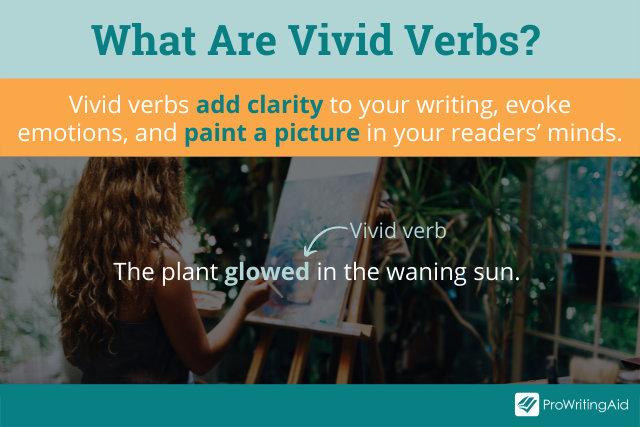
Take the verb “fall” as an example. There’s nothing wrong with the word; most people know what it means.
However, it could certainly be clearer. A fall just means downward motion; it suggests nothing about intention or distance.
Say we swap “fall” with a vivid verb like “tumble.” It’s more vivid because it implies a clumsy roll, or perhaps even an accidental fall.
Or we could use “plummet,” which paints of vivid picture of someone falling from a huge distance, likely to their doom.
Or what about “descend?” That feels much more gradual and intentional, like an airplane landing.
See how much more meaning we can get from verbs? That’s what we mean by “vivid.”
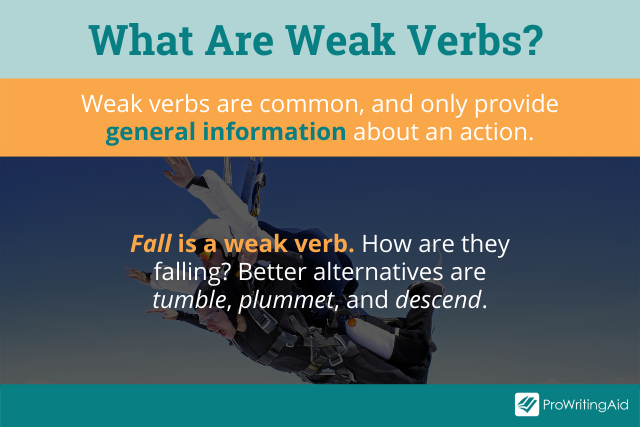
In creative writing , verbs are crucial. Action verbs are the best words for creating a picture in your readers’ minds.
Of course, adjectives and adverbs are great, but vivid verbs have motion attached to them.
UsingF vivid verbs means choosing a strong verb to paint a picture, adding clarity and specificity. Weak verbs don’t evoke the same images as vivid verbs.
How do you determine whether a verb is strong or weak?
Common verbs like walk or run are usually weak. Instead of describing how someone walks with an adjective (e.g. walks slowly ), a strong verb can provide more information about the character and the scene .
Both meanders and shuffles are synonyms for walks slowly , but these vivid verbs each evoke a different mood.
Meanders denotes a lazy pace, usually with peace. Shuffles implies that the character is feeling an emotion like sadness or embarrassment.
Let’s examine Strunk and White’s famous advice from The Elements of Style : “Omit needless words.”
This advice is especially useful for verbs, because we often use multiple words when we could use one. Take this sentence as an example:
- The dog jumped over the obstacle.
Jumped is our verb and over is our preposition .
Although this sentence functions correctly and gives us the right information, we’re using two words where one will do. Jump is not the strongest verb, and over is a needless word.
Instead, let’s try this:
- The dog hurdled the obstacle.
Not only have we used one word instead of two, we’ve also used a more vivid verb. Jump is generic, while hurdle implies athleticism.
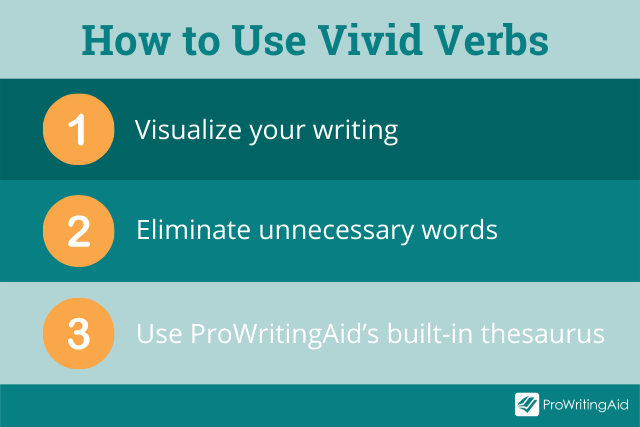
You can also visualize your work when you’re editing . Simply read a scene you’re working on aloud, then close your eyes and visualize it.
Having a hard time seeing it? That might be because your verbs aren’t specific enough. For example, imagine this line:
- She threw the ball.
When you read and visualize that line, you probably see a simple throw, but nothing particularly distinct. That’s a tell-tale sign that you’re lacking vivid verbs. So, how about this?
- She hurled the ball.
Now imagine the character getting her full weight behind the ball and having it rocket into the distance. With such a clear image, that must be a better verb!
For many of us, we don’t categorize words into types (like verbs and adjectives) as we read them. If your writing feels a little flat, you may not realize that verbs are the culprit.
Another way to visualize your verbs is by highlighting them with ProWritingAid’s Thesaurus Report . This report highlights all of the verbs in your writing so you can see which ones might need improving.
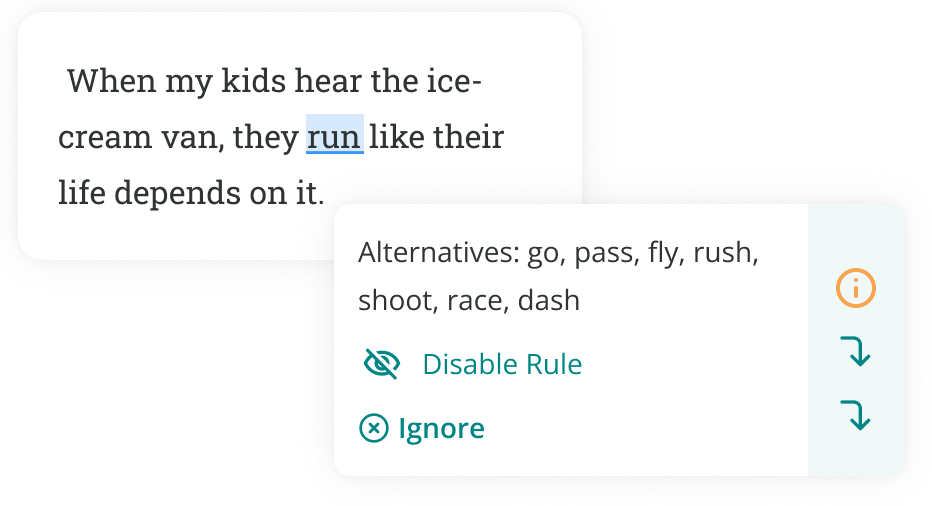
If you decide you need to swap out some of your words for more vivid verbs, you can find contextually relevant synonyms in the report.
Using ProWritingAid’s Thesaurus Report lets you see where all of the verbs are so you can edit and improve your verbs with ease.
Here are a few more examples of vivid verbs:
Weak : She looked at the book from the mysterious librarian, but saw nothing important. Vivid : She scrutinized the book from the mysterious librarian, but saw nothing important.
Weak : He said he would never forgive me. Vivid : He whispered he would never forgive me.
Weak : The soprano sang the solo with all her heart. Vivid : The soprano belted the solo with all her heart.
If you need some ideas for vivid verbs, check out our list of 50 powerful verbs to use in your writing.
Vivid verbs make for great writing. Use your words to paint a picture by swapping out your weaker verbs for stronger ones.
Take your writing to the next level:

20 Editing Tips from Professional Writers
Whether you are writing a novel, essay, article, or email, good writing is an essential part of communicating your ideas., this guide contains the 20 most important writing tips and techniques from a wide range of professional writers..

Be confident about grammar
Check every email, essay, or story for grammar mistakes. Fix them before you press send.
Krystal N. Craiker is the Writing Pirate, an indie romance author and blog manager at ProWritingAid. She sails the seven internet seas, breaking tropes and bending genres. She has a background in anthropology and education, which brings fresh perspectives to her romance novels. When she’s not daydreaming about her next book or article, you can find her cooking gourmet gluten-free cuisine, laughing at memes, and playing board games. Krystal lives in Dallas, Texas with her husband, child, and basset hound.
Get started with ProWritingAid
Drop us a line or let's stay in touch via :
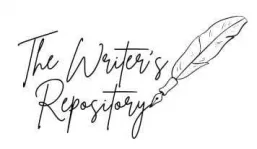
Vivid Description in Creative Writing Examples (2024)
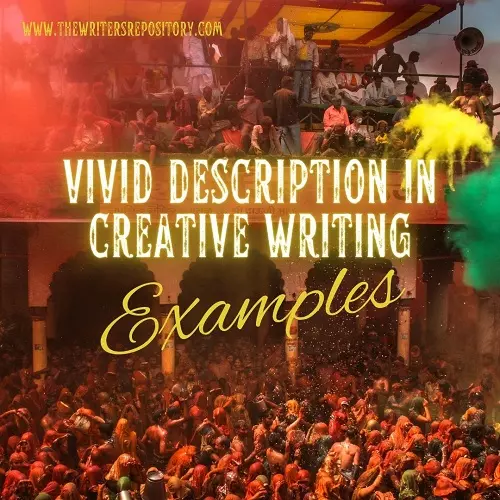
Are you looking for some vivid description in creative writing examples ? Sentences that paint the color of the sunset or the sense of excitement as one embarks for a new adventure? From authors like George R. R. Martin to Hester Fox , here are six ways to create vivid descriptions with some exquisite examples.
This post may contain affiliate links, which means that I may receive a commission, at no cost to you, if you make a purchase using these links.
Jump to Section
The Definition of Vivid Description
- Use the Five Senses
- Involve Emotions
- Inject Details
- Anthropomorphism
- Depth Perception
- Word Choice
- More at Our Site !
Related posts: Smell of Nature: Descriptions that Appeal to the Senses
When you describe something as vivid , you’re implying that it’s exceptionally clear and detailed. Vivid description is, thus, a description that’s so clear that it paints a picture in front of you, transporting you into the scene it’s describing.
We love incorporating vivid descriptions into our writing because it pulls the audience into the worlds of our creation, aids their immersion into our stories, and provides them with an intensive experience to escape from every day, mundane life.
How to Incorporate Vivid Descriptions into Our Writing (with Examples)
Read on for six ways to produce vivid descriptions with examples, ranging from the use of the five senses to word choice .
1. Use the Five Senses
The easiest way to infuse vivid descriptions into your writing is to describe what your character experiences through their five senses (sight, smell, hearing, touch, taste). Consider this quote by Hester Fox in A Lullaby for Witches , which employs the use of various senses:
I was beautiful in the summer of 1876. The rocky Tynemouth coast was an easy place to be beautiful, though, with a fresh salt breeze that brought roses to my cheeks and sun that warmed my long hair , shooting the chestnut brown through with rich veins of copper . Hester Fox
Vivid description utilized the five senses. “ A fresh salt breeze ( smell and taste )… roses to my cheeks , chestnut brown through with rich veins of copper ( sight )… sun that warmed my long hair ( touch ).”
Moreover, “ rocky coast” also automatically conjures the image of waves crashing against rock, which is evoking the sense of hearing , touch and sight .
2. Involve Emotion
Vivid descriptions don’t necessarily have to be flowery and full of bombastic words. The right word, no matter how succinct, could be very effective when it plays with the human emotion . Take a look:
“The coarse weave was scratchy against her skin, but no velvet has ever felt so fine .” George R. R. Martin
This sentence is part of a scene in A Game of Thrones , when G.R.R. Martin’s character Sandor Clegane, a Barantheon royal bodyguard, gave the Barantheon enemy’s daughter Sansa his cloak after she was stripped and humiliated at the Barantheon court.
One reason for its effectiveness is because it tugs at the heartstrings . Readers were touched by Clegane’s small yet merciful action that spared Sansa from further humiliation.
Playing with the readers’ emotion is always a smart move when done carefully. That, along with the highlighted contrast of the sense of touch ( coarse versus velvet ; scratchy versus fine ) makes this sentence really impactful.
3. Inject Details
While the previous sentence by GGRM is succinct, verbose and lyrical wordings certainly has their places in creative writing. In fact, infusing rich details into your story is another method to create vivid descriptions.
Take a look at this sentence from Honored Enemy :
He remembered how his father had told him that when it snowed even humans could see the wind , and it was so. He watched as gusty eddies danced and flickered , a single flake pausing for a moment to hover before his eyes, a twirling crystal of light, the exhale of his warm breath causing it to dance away even as it melted . Raymond E. Feist
The author colored the colorless ( when it snowed even humans could see the wind ), put a pause in a movement ( a single flake pausing for a moment to hover before his eyes ) and highlighted a transformation ( his warm breath causing the snow to melt ). They all have the effect of bringing this specific scene to life for the readers.
Here, the author also happens to use another method, which is anthropomorphism (“… gusty eddies danced …”)
We’ll look into it further in our next point.
4. Anthropomorphism
Create vivid descriptions by utilizing anthropomorphism (a literary device that involves giving non-human beings human characteristics, feelings, or intentions ). Consider this quote from The Quality of Silence :
It’s getting so hard to breathe, my lungs are filling up with ants and there isn’t room for air any more. There’s a monster made of cold, hard as the edge of a pavement , coming towards us in the dark and it’s cutting through the windscreen and doors and windows and the only weapon against it is heat, but we don’t have any heat. Rosamund Lupton
Here, vivid descriptions is achieved by attaching a sentient being’s attributes to non-sentient things (cold, a non-sentient thing, is likened to ants crawling up the lungs and monster coming from the dark).
The author also employed the use of details to bring the scene to life. She could have said, “ There’s a monster made of cold coming towards us and the only weapon against it is heat, but we don’t have any heat .”
But instead, she wrote, “ There’s a monster made of cold, hard as the edge of a pavement, coming towards us in the dark and it’s cutting through the windscreen and doors and windows and the only weapon against it is heat, but we don’t have any heat .”
The additional details transport us into the scene and we clench our teeth together with the protagonist of the story as she braces herself against the freezing weather.
5. Depth Perception
Vivid description helps the reader visualize the position of things. Words like beyond , over , above , top , bottom , high , low , instantly gives the readers a depth perception, a 3D point of view , almost, when they are picturing the scene you’re describing.
Consider this example from Tuck Everlasting :
“The first week of August hangs at the very top of summer, the top of the live-long year, like the highest seat of a Ferris wheel when it pauses in its turning. The weeks that come before are only a climb from balmy spring, and those that follow a drop to the chill of autumn, but the first week of August is motionless , and hot.” Natalie Babbit
Natalie Babbitt in this sentence used words that indicate an upper position several times (hangs at the very top of summer, the top of the live-long year, the highest seat of a Ferris wheel).
Her writing also utilized dynamic movement ( climb from a balmy spring, a drop to the chill of autumn) which indicates a flow from one position to another.
6. Word Choice
There’s no denying that word choice plays an important role in painting vivid descriptions into our writing. Describing is just as much about creating imagery and immersing the reader in a world as it is about expressing concrete information .
Consider this sentence below from Robert Lowell ‘s Collected Poems :
I saw the spiders marching through the air, swimming from tree to tree that mildewed day in latter August when the hay came creaking to the barn. – Robert Lowell
Instead of “ humid day “, the author uses “ mildewed day “ and it intensifies the sensation of that hot, summer day that suffocates the lungs with mustiness. By replacing swinging with swimming , the author paints an intriguing, zany picture in our minds.
More at our site!
There you have it, ways to create vivid description in creative writing as well as some examples. What’s your favorite one? Feel free to tell me in the comment!
Other similar posts: Smell of Nature: Exciting Descriptions
Or if you’re looking for writing prompts, check these out: Surreal Writing Prompts , Unique Zombie Ideas , or browse our Story Ideas & Writing Prompts category for more ideas.
If you have any question or feedback, don’t hesitate to reach out to me at the Contact Us page. Until next time!
Related Posts
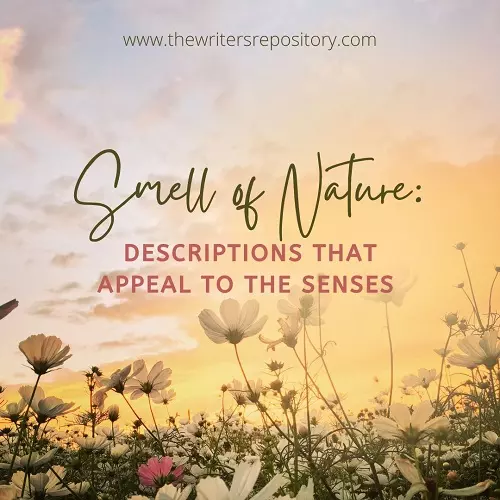
Smell of Nature: Descriptions that Appeal to the Senses (2024)
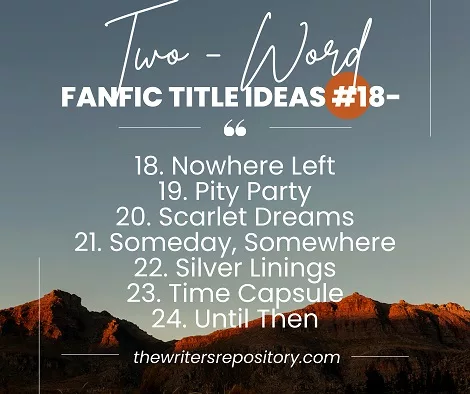
120+ Best Fanfic Title Ideas (2024)
Leave a comment cancel reply.
You must be logged in to post a comment.
Enjoy this blog? Please spread the word :)

Master the Art of Descriptive Writing with These 15 Tips
Welcome, dear reader, to a world where words weave vivid pictures and bring stories to life. In the realm of descriptive writing, the power lies in our ability to create captivating and immersive experiences through language. Whether you aspire to paint landscapes with your words, transport readers to another era, or simply refine your storytelling skills, this article is here to guide and inspire you. Get ready to embark on a journey to master the art of descriptive writing with these 15 invaluable tips that will unleash your creativity and elevate your prose.
Introduction
Why vivid descriptions are important
Vivid descriptions are essential elements in any form of writing as they have the power to captivate readers\’ attention and immerse them in the story or content. By utilizing vibrant and detailed descriptions, writers can create a more engaging and memorable experience for their readers.
Tips for Crafting Vivid Descriptions
In order to enhance your writing skills and produce vivid descriptions that truly captivate your audience, consider the following tips:
1. Engage the Senses
One of the most effective ways to create vivid descriptions is by engaging the senses of your readers. Utilize descriptive language that allows the audience to see, hear, smell, taste, and even touch what you are conveying.
For instance, rather than simply stating that the flower was beautiful, describe its vibrant colors, the sweet fragrance that lingers in the air, and the delicate petals that feel like silk against your fingertips.
By involving the senses, you can transport your readers into the world you are describing, making the experience more alive and memorable.
2. Use Strong Adjectives and Adverbs
Incorporating strong and vivid adjectives and adverbs can tremendously enhance the descriptive quality of your writing. Instead of using generic terms, opt for more precise and evocative words that paint a vivid picture in the reader\’s mind.
For example, instead of describing someone as \”tall,\” you can choose to portray them as \”towering\” or \”looming.\” These stronger adjectives provide a clearer mental image, leaving a lasting impression on your audience.
3. Show, Don\’t Tell
Instead of simply telling your readers what is happening, show them through descriptive scenes and actions. This will enable them to become active participants in your narrative, rather than passive observers.
For instance, instead of stating that a character was sad, show their drooping shoulders, tear-streaked cheeks, and quivering lips. By illustrating their emotions physically, you allow readers to sympathize and connect with the character on a deeper level.

4. Utilize Metaphors and Similes
Incorporating metaphors and similes in your descriptions adds depth and creativity to your writing. They provide a unique way to compare two unrelated things, allowing readers to understand your intended message in a more engaging and imaginative manner.
For example, describing a smile as bright as the sun, or comparing the sound of crashing waves to thunder, adds a poetic touch to your writing and leaves a lasting impact.
5. Pay Attention to the Details
Attending to the finer details in your descriptions can greatly contribute to the vividness and authenticity of your writing. Be observant and include specific and precise details that are relevant to the scene or character you are describing.
Instead of mentioning a character wore a hat, elaborate on its color, style, and how it sits on their head. These details help your readers visualize a clear image and create a more immersive reading experience.
6. Use Vivid Verbs
Selecting strong and vibrant verbs can bring your descriptions to life by portraying actions with precision and impact. Instead of using generic verbs like \”walk\” or \”run,\” opt for more vivid alternatives such as \”saunter\” or \”dart.\”
By utilizing descriptive verbs, you add depth to your writing and enable readers to visualize the actions more vividly.
7. Consider the Setting
When crafting descriptions, take the setting into account. The environment in which the scene takes place significantly impacts the atmosphere and mood of your writing.
Through careful selection of words, you can transport your readers to a different time or place. For example, describing a dark and gloomy forest creates a mysterious and eerie ambiance, while a sunny beach evokes a sense of relaxation and calmness.
8. Appeal to Emotions
Vivid descriptions have the power to evoke emotions within your readers. By carefully choosing your words, you can convey not only the physical aspects but also the emotional impact of the scene or character.
For example, instead of describing rain as simply falling from the sky, you can portray it as a cleansing force that washes away sorrow, invoking a sense of relief or renewal.
By appealing to your readers\’ emotions, your descriptions will resonate on a deeper level, leaving a lasting impression.
9. Incorporate Dialogue
Including dialogue in your descriptions can make them more dynamic and lifelike. By allowing characters to engage in conversations, you can reveal their personalities and motivations, further enhancing the overall reading experience.
For instance, instead of describing a character\’s anger, allow them to express it through fiery and passionate dialogue. This enables readers to witness the emotion firsthand and increases their connection to the narrative.
10. Practice and Refine
Becoming adept at crafting vivid descriptions takes practice and refinement. Consistently challenge yourself to experiment with different techniques and styles. Allow yourself to make mistakes and learn from them.
Seek feedback from others and make revisions accordingly. Through continuous practice and refinement, you will improve your ability to create vivid and captivating descriptions.
By employing these tips, you can elevate the quality of your writing and make your descriptions vivid, engaging, and memorable. Remember, vivid descriptions have the power to transport readers to new worlds, evoke emotions, and leave a lasting impact.
When it comes to crafting vivid descriptions in your writing, there are several techniques you can use to bring your words to life and engage your readers. In this article, we will explore the top 15 tips for creating detailed and immersive descriptions in the English language.
1. Use sensory language
One of the most effective ways to make your descriptions come alive is by appealing to the reader\’s senses. By incorporating vivid and descriptive words that evoke sight, sound, smell, taste, and touch, you can transport your readers into the world you have created. For example, instead of saying \”the forest was quiet,\” you could say \”the forest was filled with the melodic chirping of birds and the gentle rustling of leaves.\”
2. Show, don\’t tell
When describing something, it\’s important to show it through actions, emotions, and dialogue rather than simply telling the reader how it looks or feels. This technique helps the readers visualize and experience the scene or character themselves, creating a more immersive reading experience. For instance, instead of saying \”she was sad,\” you could write \”tears streamed down her face as her shoulders slumped and her voice quivered.\”
This approach allows the reader to engage with the emotions and actions of the character, and it adds depth to the description. By showing rather than telling, you invite the reader to interpret the scene or character in their own unique way, making the writing more personal and impactful.
3. Utilize similes and metaphors
Similes and metaphors are powerful tools for adding depth and creativity to your descriptions. By comparing something unfamiliar to something familiar, you can create a connection in the reader\’s mind and make the writing more engaging and memorable. For example, instead of saying \”she had a nice smile,\” you could write \”her smile was like a ray of sunshine, lighting up the room and warming everyone\’s hearts.\”
Similes use \”like\” or \”as\” to make comparisons, while metaphors state that something is something else. Both techniques can be used to bring abstract concepts to life and make them easier for the reader to understand and visualize. When using similes and metaphors, it\’s important to choose comparisons that are relevant, meaningful, and enhance the overall description.
By following these tips for crafting vivid descriptions, you will be able to create captivating and immersive writing that resonates with your readers. Remember to use sensory language, show rather than tell, and utilize similes and metaphors to bring your words to life. With practice and a keen eye for detail, you can master the art of description and engage your readers on a whole new level.
Tips for Creating Unique and Distinct Descriptions
In order to craft vivid descriptions that captivate your readers, it is essential to go beyond generic terms and provide specific and unique details. This will help paint a clear and memorable picture in the minds of your audience, leaving a lasting impression.
However, using specific details alone may not be enough to create truly captivating descriptions. To add depth and variety to your writing, it is important to consider different viewpoints and perspectives. By incorporating diverse perspectives, you can offer a multifaceted portrayal of a scene or character, making your descriptions more intriguing and realistic.
Experimenting with Different Writing Styles
When it comes to creating unique and distinct descriptions, it is crucial to experiment with different writing styles. Each style brings its own set of strengths and can enhance your descriptions in different ways. By trying out various writing styles, such as descriptive prose, poetic language, or concise imagery, you can find the one that best suits your voice and captivates your readers.
Descriptive prose is often used to create detailed and elaborate descriptions. It allows you to delve into sensory details and provide a rich and immersive experience for your readers. Through the use of vivid language, you can transport your audience to the setting of your choosing and make them feel like they are a part of the scene.
Poetic language, on the other hand, adds a lyrical and rhythmic quality to your descriptions. It can evoke emotions and create a sense of beauty in your writing. By playing with metaphors, similes, and other poetic devices, you can make your descriptions more evocative and memorable.
Concise imagery, also known as succinct descriptions, focuses on capturing the essence of a scene or character in a brief and impactful manner. It relies on carefully chosen words and phrases to create a vivid snapshot in the minds of your readers. This writing style is particularly useful when you want to convey a strong impression quickly.
By experimenting with these different writing styles, you can not only discover the one that resonates with you the most but also keep your descriptions fresh and engaging. This will prevent your writing from becoming monotonous and ensure that each description stands out in its own unique way.
In conclusion, when crafting vivid descriptions, it is important to go beyond generic terms and provide specific and unique details. Incorporating diverse perspectives and experimenting with different writing styles will further enhance your descriptions and make them more captivating. So, don\’t be afraid to step outside your comfort zone and explore various ways to bring your descriptions to life.
Tips for Balancing Description and Action
When crafting vivid descriptions in your writing, it is important to strike a balance between description and action. Here are some tips to help you achieve that balance:
1. Prioritize relevant details
When describing a scene or character, it is crucial to focus on including details that are essential to the overall narrative. Avoid overwhelming the readers with excessive information that may distract them from the main plot. By prioritizing relevant details, you can maintain a balance between description and action, which will keep the readers engaged.
2. Use descriptive moments strategically
Choosing the right moments in your writing to incorporate vivid descriptions can have a significant impact on the overall reading experience. These moments can be used to heighten emotional intensity, create suspense, or emphasize important plot points. By strategically placing descriptive moments, you can effectively capture the readers\’ attention and keep them hooked.
3. Keep the pace in mind
The pace and flow of your writing play a crucial role in maintaining reader engagement. When incorporating descriptions, it is essential to consider the desired tempo of the scene. Adjust the level of detail accordingly to ensure that the descriptions do not hinder the overall pace of the narrative. By finding the right balance between action and description, you can keep the story moving forward while still providing vivid sensory experiences for the readers.
4. Show, don\’t tell
One effective technique for balancing description and action is to use the \”show, don\’t tell\” approach. Instead of simply telling the readers what a character or scene looks like, show them through descriptive language and imagery. For example, instead of saying, \”He was sad,\” you can describe the character\’s physical appearance, body language, and facial expressions to convey their sadness. This allows the readers to form their own emotional connection to the story, making it more engaging and immersive.
Furthermore, using sensory details can also enhance the descriptive elements of your writing. Appeal to the readers\’ senses by including sounds, smells, tastes, textures, and even temperatures. This adds depth to your descriptions and helps the readers to visualize the scene or character more vividly.
In conclusion, finding the right balance between description and action is crucial for crafting vivid descriptions in your writing. Prioritizing relevant details, strategically using descriptive moments, considering the pace, and employing the \”show, don\’t tell\” technique are all effective ways to achieve this balance. By implementing these tips, you can captivate your readers and bring your writing to life.
Tips for Editing and Refining Descriptions
Once you have written your descriptions, the next step is to edit and refine them to make sure they are as vivid and engaging as possible. Here are some tips to help you with this process:
1. Use strong verbs and adjectives
One of the most effective ways to enhance your descriptions is by using strong verbs and adjectives. Replace weak and vague words with more powerful ones that can paint a clearer image or evoke a specific emotion. For example, instead of saying \”the cat walked slowly,\” you could say \”the cat sauntered.\” This simple change instantly adds more detail and liveliness to your description.
2. Read aloud and revise
Reading your descriptions aloud is a valuable editing technique that can help you identify any issues with flow, coherence, and impact. When you read your writing aloud, you are more likely to notice awkward sentences or phrases that may not be apparent when reading silently. As you go through your descriptions, revise any parts that seem unclear or do not flow smoothly. Pay attention to the rhythm and cadence of your sentences, making adjustments as needed to create a more engaging reading experience.
3. Seek feedback
Getting feedback from others is an essential part of the editing and refining process. Share your writing, particularly your descriptions, with trusted friends, family members, or colleagues, and ask for their input. Encourage them to focus specifically on your descriptions and to provide constructive criticism. Another person\’s fresh perspective can help you identify areas for improvement and offer valuable suggestions on how to enhance your writing. Be open to feedback and willing to make changes based on the comments you receive.
4. Cut unnecessary details
When editing your descriptions, it is essential to remove any unnecessary or redundant details. Sometimes, less is more, and by eliminating excess information, you can make your descriptions more powerful and focused. Go through your writing and identify any parts that do not contribute significantly to the overall image or message. Streamline your descriptions by sticking to the essentials and removing anything that may be distracting or irrelevant.
5. Use sensory language
To make your descriptions truly vivid and immersive, consider incorporating sensory language. Take advantage of the five senses – sight, sound, smell, taste, and touch – to bring your descriptions to life. Instead of simply describing how something looks, for example, include details about how it feels, sounds, or smells. This will help readers engage with your descriptions on a deeper level and create a more memorable and impactful reading experience.
Overall, the editing and refining process plays a crucial role in crafting vivid descriptions. By using strong verbs and adjectives, reading aloud and revising, seeking feedback, cutting unnecessary details, and incorporating sensory language, you can elevate your writing and captivate your readers. Remember to take your time and be diligent in your editing efforts to ensure that your descriptions are as effective and compelling as possible.
Related posts:
- Unlocking the Secrets to Crafting Authentic and Extraordinary Fantasy Realms
- Mastering the Art of Crafting a Compelling Author Bio
- Conquering Impostor Syndrome: A Guide for Writers
- When to Edit Your Writing: A Comprehensive Guide
Leave a Reply Cancel reply
Your email address will not be published. Required fields are marked *
Save my name, email, and website in this browser for the next time I comment.
Break the Mindset
Discover your full potential with 'Break the Mindset.' Our blog is your guide to personal growth and transformation. Break free from limiting beliefs, overcome challenges, and create a life of purpose and fulfillment. Join us on this journey of self-discovery.
Important Link
- Privacy Policy
Improve your writing in one of the largest and most successful writing groups online
Join our writing group!
What are “Vivid Verbs,” And How They Lead to Stronger Writing

by Fija Callaghan
Do you ever go over a rough draft and wonder why it’s not quite landing as strongly as you’d hoped? Maybe the characterization is solid and the plot points are all artfully arranged, but it’s just not hitting the desired emotional impact. It might be that your prose is a victim of weak verbs , which are keeping it from being the very best it can be.
As you may remember from primary school, verbs are carriers of action—and action is the carrier of story. That means finding the right descriptive verb for the right moment can go a long way when it comes to elevating your work.
Let’s look at what it means to use vivid verbs in writing, how to get rid of some of the more tedious common verbs in your work, and some examples of vivid verbs that you can shamelessly pilfer to take your story to the next level.
What are vivid verbs?
“Vivid verbs” are active words that convey a clear, concise, and evocative action to the reader, and that are strong enough to stand alone without additional adverbs or description. For example, “shuffle” and “saunter” are two vivid verbs that describe the act of walking, each with different connotations and imagery, that we can use instead of saying “walked slowly” or “walked lazily.”
Another example might be variations of the word “eat.” If you have a character eating in a scene, that can mean a lot of different things depending on who the character is and what sort of preconceptions the reader is carrying with them. Instead of “eat” you could say nibble, inhale, graze, taste, or devour. Each of these vivid verbs conveys something different about both the character and the situation.
Why are vivid verbs useful for writers?
In creative writing, verbs are what keep the story moving. Characters doing, wanting, going, destroying, creating. It’s easy to fall back on broad, boring verbs that paint the characters’ actions in wide, clunky strokes; however, that generality holds your reader at a distance from your story.
By finding just the right word to encompass what’s happening on the page, you create a vivid picture that pulls the reader into the action. The more specific you can be, the more your story will start to come alive. That’s why landing on the perfect vivid verb can lift a basic sentence or paragraph into something transcendent.

The same applies to all kinds of writing, even if you’re not crafting fictional characters. If you’re writing poetry, memoir, persuasive essays, or even professional emails (the modern persuasive essay), using powerful verbs will help your words resonate in the reader’ mind.
The ultimate list of vivid verbs
Ready to incorporate some more exciting verbs into your work (and level up your writing skills)? Here are some strong action verbs to get you started.
Vivid verbs for movement
perambulate

Vivid verbs for communicating

Vivid verbs for acknowledgment
accommodate
Vivid verbs for emotions

Vivid verbs for food and drink
Vivid verbs for creation.
manufacture
Vivid verbs for sound

Tips for finding the right vivid verbs
Now you have an entire arsenal of strong verbs at your fingertips to bring your writing to life! But how do you choose exactly the right active verb for the right moment?
The first step is to simply nurture your vocabulary (hint: I wrote “expand” and “grow” your vocabulary before I settled on “nurture” as exactly what I was trying to say). Make friends with your thesaurus. Words that may seem like synonyms at first will reveal slightly different meanings, like adjacent colors on a color wheel: they may both be white , but this one says “cottage garden” while this other one says “business class.”
Sometimes, finding a more descriptive verb might come through your revision process. When you’re looking back over your first draft, keep an eye out for weak, passive verbs that aren’t doing much to support the narrative. These will be generalizations like “walk,” “go,” “make,” “talk,” “eat,” “like,” “dislike,” and so forth.
When you come across a weak verb like this, ask yourself if it’s the best possible fit the English language has to offer you. Sometimes , a simple word might be enough; for instance, there’s not much that outshines “said” in a dialogue tag . You don’t need to use creative language in every single sentence (unless you’re Angela Carter). Often, however, it’s helpful to challenge yourself to find more vivid verbs to replace these broad strokes.
Examples of effective vivid verbs
Consider the following examples:
Realizing her mistake, she ran back to the classroom.
“Ran” in this context is a bit wishy-washy. It’s not doing any harm, but it could be better. Is there a more vivid verb we can use instead?
Consider “barrelled,” “darted,” “catapulted,” “raced,” “sped,” “bolted,” or “sprinted.” Each of them feels a little bit different, like finding the right puzzle piece. What you know of your character, setting, and circumstance will help you determine the one word that’s the perfect fit.
With the vivid verb treatment:
Realizing her mistake, she bolted back to the classroom.

Here’s another gasping fish of a sentence to consider:
He liked his new co-worker.
“Liked” is a boring verb that covers a lot of ground; it doesn’t tell us very much. What about:
“Respected,” “appreciated,” “desired,” “enjoyed,” “loved,” “craved,” “adored,” “favored,” “admired,” “idolized,” or “fancied. ”
He admired his new co-worker.
Suddenly, with a strong verb and an active voice, these characters and this place feel alive.
Strong verbs create a vivid picture in the reader’s mind
Sometimes, it’s the smallest adjustments that make the biggest difference in our writing—whether it’s an academic article, a novel, short stories, or personal essays. Professional writers know to make their work as clear and concise as possible, which means snipping out those boring verbs and replacing them with interesting word choices that bring the narrative to life.
Get feedback on your writing today!
Scribophile is a community of hundreds of thousands of writers from all over the world. Meet beta readers, get feedback on your writing, and become a better writer!
Join now for free

Related articles

How to Use a Semicolon in Writing: Examples and Semicolon Rules

How to Start Writing a Book

How & When to Use a Colon in Creative Writing

Single vs. Double Quotes: How & When to Use Quotation Marks

When to Use an Apostrophe | Proper Apostrophe Use + Examples

What is a Comma Splice? Definition & Examples

Word Choice
What this handout is about.
This handout can help you revise your papers for word-level clarity, eliminate wordiness and avoid clichés, find the words that best express your ideas, and choose words that suit an academic audience.
Introduction
Writing is a series of choices. As you work on a paper, you choose your topic, your approach, your sources, and your thesis; when it’s time to write, you have to choose the words you will use to express your ideas and decide how you will arrange those words into sentences and paragraphs. As you revise your draft, you make more choices. You might ask yourself, “Is this really what I mean?” or “Will readers understand this?” or “Does this sound good?” Finding words that capture your meaning and convey that meaning to your readers is challenging. When your instructors write things like “awkward,” “vague,” or “wordy” on your draft, they are letting you know that they want you to work on word choice. This handout will explain some common issues related to word choice and give you strategies for choosing the best words as you revise your drafts.
As you read further into the handout, keep in mind that it can sometimes take more time to “save” words from your original sentence than to write a brand new sentence to convey the same meaning or idea. Don’t be too attached to what you’ve already written; if you are willing to start a sentence fresh, you may be able to choose words with greater clarity.
For tips on making more substantial revisions, take a look at our handouts on reorganizing drafts and revising drafts .
“Awkward,” “vague,” and “unclear” word choice
So: you write a paper that makes perfect sense to you, but it comes back with “awkward” scribbled throughout the margins. Why, you wonder, are instructors so fond of terms like “awkward”? Most instructors use terms like this to draw your attention to sentences they had trouble understanding and to encourage you to rewrite those sentences more clearly.
Difficulties with word choice aren’t the only cause of awkwardness, vagueness, or other problems with clarity. Sometimes a sentence is hard to follow because there is a grammatical problem with it or because of the syntax (the way the words and phrases are put together). Here’s an example: “Having finished with studying, the pizza was quickly eaten.” This sentence isn’t hard to understand because of the words I chose—everybody knows what studying, pizza, and eating are. The problem here is that readers will naturally assume that first bit of the sentence “(Having finished with studying”) goes with the next noun that follows it—which, in this case, is “the pizza”! It doesn’t make a lot of sense to imply that the pizza was studying. What I was actually trying to express was something more like this: “Having finished with studying, the students quickly ate the pizza.” If you have a sentence that has been marked “awkward,” “vague,” or “unclear,” try to think about it from a reader’s point of view—see if you can tell where it changes direction or leaves out important information.
Sometimes, though, problems with clarity are a matter of word choice. See if you recognize any of these issues:
- Misused words —the word doesn’t actually mean what the writer thinks it does. Example : Cree Indians were a monotonous culture until French and British settlers arrived. Revision: Cree Indians were a homogenous culture.
- Words with unwanted connotations or meanings. Example : I sprayed the ants in their private places. Revision: I sprayed the ants in their hiding places.
- Using a pronoun when readers can’t tell whom/what it refers to. Example : My cousin Jake hugged my brother Trey, even though he didn’t like him very much. Revision: My cousin Jake hugged my brother Trey, even though Jake doesn’t like Trey very much.
- Jargon or technical terms that make readers work unnecessarily hard. Maybe you need to use some of these words because they are important terms in your field, but don’t throw them in just to “sound smart.” Example : The dialectical interface between neo-Platonists and anti-disestablishment Catholics offers an algorithm for deontological thought. Revision : The dialogue between neo-Platonists and certain Catholic thinkers is a model for deontological thought.
- Loaded language. Sometimes we as writers know what we mean by a certain word, but we haven’t ever spelled that out for readers. We rely too heavily on that word, perhaps repeating it often, without clarifying what we are talking about. Example : Society teaches young girls that beauty is their most important quality. In order to prevent eating disorders and other health problems, we must change society. Revision : Contemporary American popular media, like magazines and movies, teach young girls that beauty is their most important quality. In order to prevent eating disorders and other health problems, we must change the images and role models girls are offered.
Sometimes the problem isn’t choosing exactly the right word to express an idea—it’s being “wordy,” or using words that your reader may regard as “extra” or inefficient. Take a look at the following list for some examples. On the left are some phrases that use three, four, or more words where fewer will do; on the right are some shorter substitutes:
Keep an eye out for wordy constructions in your writing and see if you can replace them with more concise words or phrases.
In academic writing, it’s a good idea to limit your use of clichés. Clichés are catchy little phrases so frequently used that they have become trite, corny, or annoying. They are problematic because their overuse has diminished their impact and because they require several words where just one would do.
The main way to avoid clichés is first to recognize them and then to create shorter, fresher equivalents. Ask yourself if there is one word that means the same thing as the cliché. If there isn’t, can you use two or three words to state the idea your own way? Below you will see five common clichés, with some alternatives to their right. As a challenge, see how many alternatives you can create for the final two examples.
Try these yourself:
Writing for an academic audience
When you choose words to express your ideas, you have to think not only about what makes sense and sounds best to you, but what will make sense and sound best to your readers. Thinking about your audience and their expectations will help you make decisions about word choice.
Some writers think that academic audiences expect them to “sound smart” by using big or technical words. But the most important goal of academic writing is not to sound smart—it is to communicate an argument or information clearly and convincingly. It is true that academic writing has a certain style of its own and that you, as a student, are beginning to learn to read and write in that style. You may find yourself using words and grammatical constructions that you didn’t use in your high school writing. The danger is that if you consciously set out to “sound smart” and use words or structures that are very unfamiliar to you, you may produce sentences that your readers can’t understand.
When writing for your professors, think simplicity. Using simple words does not indicate simple thoughts. In an academic argument paper, what makes the thesis and argument sophisticated are the connections presented in simple, clear language.
Keep in mind, though, that simple and clear doesn’t necessarily mean casual. Most instructors will not be pleased if your paper looks like an instant message or an email to a friend. It’s usually best to avoid slang and colloquialisms. Take a look at this example and ask yourself how a professor would probably respond to it if it were the thesis statement of a paper: “Moulin Rouge really bit because the singing sucked and the costume colors were nasty, KWIM?”
Selecting and using key terms
When writing academic papers, it is often helpful to find key terms and use them within your paper as well as in your thesis. This section comments on the crucial difference between repetition and redundancy of terms and works through an example of using key terms in a thesis statement.
Repetition vs. redundancy
These two phenomena are not necessarily the same. Repetition can be a good thing. Sometimes we have to use our key terms several times within a paper, especially in topic sentences. Sometimes there is simply no substitute for the key terms, and selecting a weaker term as a synonym can do more harm than good. Repeating key terms emphasizes important points and signals to the reader that the argument is still being supported. This kind of repetition can give your paper cohesion and is done by conscious choice.
In contrast, if you find yourself frustrated, tiredly repeating the same nouns, verbs, or adjectives, or making the same point over and over, you are probably being redundant. In this case, you are swimming aimlessly around the same points because you have not decided what your argument really is or because you are truly fatigued and clarity escapes you. Refer to the “Strategies” section below for ideas on revising for redundancy.
Building clear thesis statements
Writing clear sentences is important throughout your writing. For the purposes of this handout, let’s focus on the thesis statement—one of the most important sentences in academic argument papers. You can apply these ideas to other sentences in your papers.
A common problem with writing good thesis statements is finding the words that best capture both the important elements and the significance of the essay’s argument. It is not always easy to condense several paragraphs or several pages into concise key terms that, when combined in one sentence, can effectively describe the argument.
However, taking the time to find the right words offers writers a significant edge. Concise and appropriate terms will help both the writer and the reader keep track of what the essay will show and how it will show it. Graders, in particular, like to see clearly stated thesis statements. (For more on thesis statements in general, please refer to our handout .)
Example : You’ve been assigned to write an essay that contrasts the river and shore scenes in Mark Twain’s Huckleberry Finn. You work on it for several days, producing three versions of your thesis:
Version 1 : There are many important river and shore scenes in Huckleberry Finn.
Version 2 : The contrasting river and shore scenes in Huckleberry Finn suggest a return to nature.
Version 3 : Through its contrasting river and shore scenes, Twain’s Huckleberry Finn suggests that to find the true expression of American democratic ideals, one must leave “civilized” society and go back to nature.
Let’s consider the word choice issues in these statements. In Version 1, the word “important”—like “interesting”—is both overused and vague; it suggests that the author has an opinion but gives very little indication about the framework of that opinion. As a result, your reader knows only that you’re going to talk about river and shore scenes, but not what you’re going to say. Version 2 is an improvement: the words “return to nature” give your reader a better idea where the paper is headed. On the other hand, they still do not know how this return to nature is crucial to your understanding of the novel.
Finally, you come up with Version 3, which is a stronger thesis because it offers a sophisticated argument and the key terms used to make this argument are clear. At least three key terms or concepts are evident: the contrast between river and shore scenes, a return to nature, and American democratic ideals.
By itself, a key term is merely a topic—an element of the argument but not the argument itself. The argument, then, becomes clear to the reader through the way in which you combine key terms.
Strategies for successful word choice
- Be careful when using words you are unfamiliar with. Look at how they are used in context and check their dictionary definitions.
- Be careful when using the thesaurus. Each word listed as a synonym for the word you’re looking up may have its own unique connotations or shades of meaning. Use a dictionary to be sure the synonym you are considering really fits what you are trying to say.
- Under the present conditions of our society, marriage practices generally demonstrate a high degree of homogeneity.
- In our culture, people tend to marry others who are like themselves. (Longman, p. 452)
- Before you revise for accurate and strong adjectives, make sure you are first using accurate and strong nouns and verbs. For example, if you were revising the sentence “This is a good book that tells about the Revolutionary War,” think about whether “book” and “tells” are as strong as they could be before you worry about “good.” (A stronger sentence might read “The novel describes the experiences of a soldier during the Revolutionary War.” “Novel” tells us what kind of book it is, and “describes” tells us more about how the book communicates information.)
- Try the slash/option technique, which is like brainstorming as you write. When you get stuck, write out two or more choices for a questionable word or a confusing sentence, e.g., “questionable/inaccurate/vague/inappropriate.” Pick the word that best indicates your meaning or combine different terms to say what you mean.
- Look for repetition. When you find it, decide if it is “good” repetition (using key terms that are crucial and helpful to meaning) or “bad” repetition (redundancy or laziness in reusing words).
- Write your thesis in five different ways. Make five different versions of your thesis sentence. Compose five sentences that express your argument. Try to come up with four alternatives to the thesis sentence you’ve already written. Find five possible ways to communicate your argument in one sentence to your reader. (We’ve just used this technique—which of the last five sentences do you prefer?)Whenever we write a sentence we make choices. Some are less obvious than others, so that it can often feel like we’ve written the sentence the only way we know how. By writing out five different versions of your thesis, you can begin to see your range of choices. The final version may be a combination of phrasings and words from all five versions, or the one version that says it best. By literally spelling out some possibilities for yourself, you will be able to make better decisions.
- Read your paper out loud and at… a… slow… pace. You can do this alone or with a friend, roommate, TA, etc. When read out loud, your written words should make sense to both you and other listeners. If a sentence seems confusing, rewrite it to make the meaning clear.
- Instead of reading the paper itself, put it down and just talk through your argument as concisely as you can. If your listener quickly and easily comprehends your essay’s main point and significance, you should then make sure that your written words are as clear as your oral presentation was. If, on the other hand, your listener keeps asking for clarification, you will need to work on finding the right terms for your essay. If you do this in exchange with a friend or classmate, rest assured that whether you are the talker or the listener, your articulation skills will develop.
- Have someone not familiar with the issue read the paper and point out words or sentences they find confusing. Do not brush off this reader’s confusion by assuming they simply doesn’t know enough about the topic. Instead, rewrite the sentences so that your “outsider” reader can follow along at all times.
- Check out the Writing Center’s handouts on style , passive voice , and proofreading for more tips.
Questions to ask yourself
- Am I sure what each word I use really means? Am I positive, or should I look it up?
- Have I found the best word or just settled for the most obvious, or the easiest, one?
- Am I trying too hard to impress my reader?
- What’s the easiest way to write this sentence? (Sometimes it helps to answer this question by trying it out loud. How would you say it to someone?)
- What are the key terms of my argument?
- Can I outline out my argument using only these key terms? What others do I need? Which do I not need?
- Have I created my own terms, or have I simply borrowed what looked like key ones from the assignment? If I’ve borrowed the terms, can I find better ones in my own vocabulary, the texts, my notes, the dictionary, or the thesaurus to make myself clearer?
- Are my key terms too specific? (Do they cover the entire range of my argument?) Can I think of specific examples from my sources that fall under the key term?
- Are my key terms too vague? (Do they cover more than the range of my argument?)
Works consulted
We consulted these works while writing this handout. This is not a comprehensive list of resources on the handout’s topic, and we encourage you to do your own research to find additional publications. Please do not use this list as a model for the format of your own reference list, as it may not match the citation style you are using. For guidance on formatting citations, please see the UNC Libraries citation tutorial . We revise these tips periodically and welcome feedback.
Anson, Chris M., and Robert A. Schwegler. 2010. The Longman Handbook for Writers and Readers , 6th ed. New York: Longman.
Cook, Claire Kehrwald. 1985. Line by Line: How to Improve Your Own Writing . Boston: Houghton Mifflin.
Grossman, Ellie. 1997. The Grammatically Correct Handbook: A Lively and Unorthodox Review of Common English for the Linguistically Challenged . New York: Hyperion.
Houghton Mifflin. 1996. The American Heritage Book of English Usage: A Practical and Authoritative Guide to Contemporary English . Boston: Houghton Mifflin.
O’Conner, Patricia. 2010. Woe Is I: The Grammarphobe’s Guide to Better English in Plain English , 3rd ed. New York: Penguin Publishing Group.
Tarshis, Barry. 1998. How to Be Your Own Best Editor: The Toolkit for Everyone Who Writes . New York: Three Rivers Press.
Williams, Joseph, and Joseph Bizup. 2017. Style: Lessons in Clarity and Grace , 12th ed. Boston: Pearson.
You may reproduce it for non-commercial use if you use the entire handout and attribute the source: The Writing Center, University of North Carolina at Chapel Hill
Make a Gift
Descriptive Essay Tips: Using Sensory & Feeling Words
1. define your focus, choose a specific topic, identify your audience, create a thesis statement, 2. build your vocabulary, use thesaurus, read broadly, practice writing, 3. apply sensory words, describe sight, describe sound, describe touch, 4. utilize feeling words, express emotions, capture the mood, convey atmosphere, 5. create vivid imagery, use metaphors, apply similes, incorporate symbolism, 6. revise and edit, review your work, check for clarity, polish your essay.
Delving into the world of descriptive essays, one question that often comes up is "which type of essay relies on sensory and feeling words?" Well, you've guessed right—the descriptive essay. It's like painting a picture with words, where each stroke is a sensory or feeling word. This blog post will guide you through the process of enhancing your descriptive essays with sensory and feeling words, along with other essential elements, which will help you create a masterpiece every time.
Before you begin writing your descriptive essay, it's important to have a clear focus. This involves choosing a specific topic, identifying your audience, and creating a compelling thesis statement.
Choosing a topic for your descriptive essay can be exciting, yet daunting. It's like being at a buffet where you can pick anything, but you need to choose wisely. The key is to pick a subject that you can describe vividly—something that piques your interest and evokes strong senses or emotions. It could be a person, a place, an object, or an experience. For instance, writing about the Grand Canyon can provide ample opportunities to use sensory and feeling words.
Knowing your audience is like having a GPS for your essay—it helps you navigate the content. Are you writing for your peers, your teacher, or the public? Understanding your audience will help you determine the level of detail and the type of language to use. For example, if you're writing for your classmates in middle school, you might want to avoid complex words and keep the descriptions simple and relatable.
Last but not least, you need a solid thesis statement—a compass to guide your essay. Your thesis statement should give a hint about what your essay is about and how you are going to describe it. For instance, if you're writing about a summer day at the beach, your thesis statement could be: "A summer day at the beach is like a symphony where the elements of nature come together to create a sensory extravaganza."
Writing a descriptive essay is like painting with words, and your vocabulary is your color palette. The more words you have at your disposal, the richer and more vivid your description will be. So, how can you expand your vocabulary? Here are some ways.
Thesaurus is your best friend when it comes to finding synonyms and antonyms. It's like a treasure chest of words waiting to be discovered. Want to describe how delicious the apple pie tasted? Instead of using the word 'delicious', you can find alternatives like 'scrumptious', 'mouthwatering', or 'delectable'. This not only makes your essay more interesting but also increases its sensory appeal.
Reading is like taking a journey through different worlds and times. Each book, article, or blog post you read is an opportunity to learn new words and phrases. Pay attention to how authors describe characters, settings, and events. Notice the sensory and feeling words they use. From the crisp autumn air in a mystery novel to the palpable tension in a thriller, reading widely will equip you with a wealth of words to use in your essays.
Just as a musician practices scales or a basketball player practices shooting hoops, a writer should practice writing. Regular writing exercises will help you become comfortable with using new words and expressions. Try describing your morning routine, your favorite meal, or a memorable vacation. Remember, practice makes perfect, and in the case of descriptive essays, practice makes vivid!
Now that you've got your vocabulary toolbox ready, it's time to dive into the core of descriptive writing. Which type of essay relies on sensory and feeling words? You guessed it - a descriptive essay. Using sensory words is like adding spices to a dish—it brings out the flavors, making it more appealing and enjoyable. So, let's explore the sensory words associated with sight, sound, and touch.
Sight is perhaps the most utilized sense in descriptive writing. It's about painting a picture with words. When describing a place, don't just say it's 'beautiful'. Is it a serene lakeside with glistening waters reflecting the dazzling sunset? Or is it a bustling cityscape with towering skyscrapers piercing the cerulean sky? The more specific you are with your visuals, the more vivid your essay will be.
Sound adds another layer to your descriptions. It's not just about what the reader can see, but also what they can hear. Was the rain 'pattering' against the window, or was it 'drumming' heavily on the rooftop? Did the wind 'whisper' through the trees, or did it 'howl' in the night? Choosing the right words can make your descriptions come alive.
Touch is a powerful sense that can add depth to your descriptions. Was the blanket 'soft and fluffy' like a cloud, or was the pavement 'rough and gritty' under your feet? By including tactile details, you engage your reader's sense of touch, making your descriptions more immersive and realistic.
Now, let's dive a bit deeper. Sensory words help your reader visualize, hear, and feel the physical aspects of your description. But what about the emotional landscape? That's where feeling words come into play. They evoke emotions and set the mood, further enriching the descriptive essay experience. So, which type of essay relies on sensory and feeling words? Still wondering? Let's solidify your understanding through the power of emotion.
Feeling words are like the soul of your descriptive essay. They bring the emotions of your characters or your own feelings to life. Saying 'I was happy' is fine, but wouldn't it be more impactful to say 'I was overjoyed, elated, my heart brimming with happiness'? The right choice of feeling words can make your reader feel right there with you.
Setting the mood is a powerful storytelling technique. It's about creating an emotional atmosphere that pulls the reader in. Was the abandoned house 'creepy', making your heart pound with 'fear'? Or was the spring morning 'refreshing', filling you with 'calm and serenity'? The mood you set can shape the reader's experience and interpretation of your essay.
Atmosphere goes hand in hand with mood. It's about the overall feeling or vibe of a place or situation. It can be a 'tense' atmosphere in a thriller, a 'romantic' atmosphere in a love story, or a 'melancholic' atmosphere in a tale of loss. Selecting the right feeling words can help you build a compelling atmosphere that resonates with your readers.
Alright, you're almost there. You've got your focus, you've built your vocabulary, learned how to apply sensory and feeling words, but now comes the fun part: creating vivid imagery. This is where your descriptive essay truly comes alive. It's like painting a picture with words. Which type of essay relies on sensory and feeling words? The one that paints a vivid picture in the reader's mind.
Metaphors are a powerful tool for creating vivid imagery. They compare two things without using 'like' or 'as'. For instance, saying 'time is a thief' is more impactful and creates a stronger image than simply saying 'time goes by quickly'. Metaphors allow you to express complex ideas or emotions in a simple, relatable way.
Similes, like metaphors, create strong images. The difference is that similes use 'like' or 'as' for the comparison. Saying 'she ran like the wind' paints a more vivid picture than just saying 'she ran fast'. Similes can help your readers better understand and visualize your descriptions.
Symbolism allows you to convey a deeper meaning through objects, actions, or people. For example, a dove often symbolizes peace. So, if a dove appears in your essay at a critical moment, it could symbolize the arrival of peace. Symbolism can add an extra layer of depth to your essay, making it more engaging and thought-provoking for your readers.
Now, you’ve done the hard work of creating your descriptive essay, but hold on, you're not quite finished yet. Remember, the magic happens in the editing. This is your opportunity to really make your essay shine. So, let's dive into those final steps: Review, Check, and Polish.
First things first, take a break. Yes, you read that right! Step away from your work for a while. This will allow you to come back with a fresh set of eyes and spot things you might have missed. Once you're ready, read through your essay. Does it flow well? Have you painted a clear picture? Have you used enough sensory and feeling words? Remember, a descriptive essay— which is the type of essay that relies on sensory and feeling words— should make your reader feel like they're right there with you.
After a thorough review, it's time to check for clarity. Make sure your sentences are clear and concise. Remove any unnecessary words or phrases. Check if your metaphors, similes, and symbolism are clear and add value to your essay. At the end of this stage, your reader should have no trouble understanding your essay and visualizing your descriptions.
Last but not least, polish your essay. This is where you check for spelling, grammar, and punctuation errors. But don't just rely on spell check, read your essay out loud. This helps catch awkward phrases or sentence structures. And remember, perfection is a myth. The goal is to create an engaging, vivid, and clear descriptive essay.
So, there you have it! You're now ready to write a descriptive essay that not only paints a vivid picture but also engages and captivates your readers. Happy writing!
If you want to dive deeper into using sensory and feeling words in your descriptive essays, don't miss Celina Rodriguez's workshop titled ' How to Use Your Senses for Inspiration .' This workshop will guide you through techniques and exercises that will help you harness the power of your senses to create more vivid and engaging written content.

Live classes every day
Learn from industry-leading creators
Get useful feedback from experts and peers
Best deal of the year
* billed annually after the trial ends.
*Billed monthly after the trial ends.

Descriptive Writing Prompt: Paint Vivid Imagery with Words
My name is Debbie, and I am passionate about developing a love for the written word and planting a seed that will grow into a powerful voice that can inspire many.

Painting a Scene: How to Capture Vivid Imagery in Descriptive Writing
Choosing the right words, creating a sensory experience, creating a visual experience: tips for engaging the senses in descriptive writing, choosing the right words: enhancing imagery with strong adjectives and descriptive language, enhancing imagery with strong adjectives and descriptive language, setting the stage: utilizing setting and atmosphere to enhance descriptive writing, appealing to the reader’s emotions: using metaphors and similes to evoke vivid imagery, transporting readers: creating a sense of place through rich and detailed descriptions, 1. engage the senses:, 2. show, don’t tell:, frequently asked questions, insights and conclusions.
When it comes to descriptive writing, the words you select can make all the difference in painting a vivid scene in the reader’s mind. To capture the essence of a scene, it’s essential to choose words that evoke the desired imagery. Instead of simply describing what you see, try incorporating sensory details that engage the reader’s senses. For example, instead of saying “The sun was setting,” you could say “The sun melted into the horizon, painting the sky with fiery hues of orange and pink.” By adding descriptive words such as “melted” and “fiery hues,” you create a more vibrant and captivating image for your readers.
Moreover, utilizing strong and vivid verbs can further enhance the imagery in your writing. Instead of relying solely on adjectives, consider using verbs that convey motion or action. For instance, instead of describing a flowing river with adjectives like “wide” or “beautiful,” you could use verbs like “gushed” or “rushed,” which animate the scene and bring it to life. Additionally, using figurative language such as metaphors or similes can add depth to your descriptions. Compare a quiet forest to a “whispering cathedral of trees” to evoke a sense of peacefulness and tranquility.
To make your descriptive writing truly vivid, it’s crucial to engage the reader’s senses. By incorporating sensory details, you can transport your readers directly into the world you’re describing. Include descriptive language that appeals to sight, sound, touch, taste, and smell. For instance, instead of simply stating that the air was cold, you could describe it as being “crisp and biting, sending shivers down your spine.” By evoking the sensation of coldness, you immerse your readers in the scene and make them feel a part of it.
Take advantage of similes and metaphors to create sensory connections that are relatable and comprehensible. By comparing a beach to “a soft, golden blanket stretching as far as the eye can see,” you provide both a visual and tactile image that engages the reader. Additionally, don’t forget to incorporate sounds and scents. Describe the melodic chirping of birds or the aroma of freshly baked bread wafting through the air. By including these sensory details, you bring your descriptive writing to life, making it more engaging and memorable for your audience.

Tips for Engaging the Senses in Descriptive Writing
When it comes to descriptive writing, captivating your reader’s imagination is key. Creating a vivid visual experience through your words can transport your audience to another time and place. To help you engage the senses and bring your writing to life, here are some tips to consider:
- Use descriptive language: Paint a picture with your words by using adjectives and adverbs that appeal to the senses. Instead of saying “the house was old,” try “the dilapidated house creaked with the weight of its years.”
- Incorporate sensory details: Engage your reader’s senses by including specific details about sight, sound, smell, taste, and touch. For example, when describing a bustling marketplace, mention the vibrant colors of the stalls, the lively chatter of the vendors, and the enticing aroma of freshly brewed coffee .
- Create vivid imagery: Draw upon metaphors, similes, and analogies to add depth and richness to your descriptions. Comparing a thunderstorm to an angry giant unleashing its fury can help your readers visualize and feel the power of the storm.
Remember, descriptive writing is an art form that enables readers to fully immerse themselves in the narrative. By appealing to the senses, using descriptive language, and creating vivid imagery, you can craft a visual experience that will captivate and engage your audience.
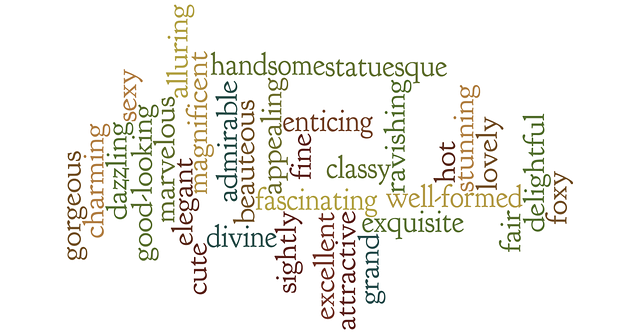
When it comes to painting vivid pictures in the minds of our readers, choosing the right words is absolutely vital. By incorporating strong adjectives and descriptive language into our writing, we can transport our audience to different worlds, evoke powerful emotions, and create unforgettable experiences. Here are some tips to help you master the art of enhancing imagery in your writing:
- Select specific adjectives: Instead of settling for generic adjectives like “nice” or “pretty,” dig deeper and choose words that precisely capture the essence of what you are describing. For example, instead of saying “the flower was beautiful,” you could use “the enchanting flower bloomed with vibrant colors, captivating every eye that beheld it.”
- Appeal to the senses: In order to immerse your readers into your world, utilize descriptive language that engages their senses. Describing how something looks, sounds, tastes, smells, or feels can make your writing incredibly vivid and engaging. For instance, instead of merely stating “the cake tasted good,” you could say “as I took a bite of the luscious chocolate cake, its velvety smoothness melted on my tongue, the bittersweet flavor wrapping my taste buds in pure ecstasy.”
- Paint a visual image with comparisons: Comparisons can be a powerful tool to enhance the imagery in your writing. Utilize similes or metaphors to describe things in a unique and relatable way. For example, instead of saying “the sunset was beautiful,” you could write “the sunset painted the sky in hues of blazing red and golden orange, as if nature’s canvas was ablaze with the fiery passion of a celestial artist.”
Making the conscious effort to infuse your writing with strong adjectives and descriptive language will elevate your words from mere sentences on a page to captivating journeys for your readers. Remember, the right words have the power to unlock limitless possibilities, so embrace your creativity and let your imagination run wild!

When it comes to crafting vivid and captivating descriptive writing, one cannot underestimate the power of setting and atmosphere. These two key elements provide the foundation for immersing readers into a world of sights, sounds, and emotions. By carefully incorporating the right settings and cultivating the appropriate atmosphere, writers can elevate their descriptive works to new heights, making them truly unforgettable.
To effectively utilize setting, authors must pay attention to the intricate details that bring a location to life. Whether it’s a bustling city street or a serene countryside, painting a picture with words helps readers to visualize the surroundings. By vividly describing the physical attributes of the setting, such as the colors, textures, or even the weather, writers can transport their audience to a different time and place.
- Create a sensory experience: Engage readers’ senses by describing the smells, sounds, and tastes associated with the setting. This multi-dimensional approach allows readers to feel fully immersed in the world being depicted.
- Establish a mood: The atmosphere of a setting plays a crucial role in evoking emotions and setting the tone of a scene. Whether it’s a hauntingly eerie forest or a joyous beach, choosing the right words and phrases will help create the desired ambiance and enhance readers’ emotional journey.
- Utilize symbolism: Combine the physical attributes of a setting with symbolic significance to deepen the meaning behind a scene. For example, a dilapidated house can represent the decay of a character’s psyche, adding layers of depth to your descriptive writing.
By masterfully crafting settings and atmosphere, writers can transform the ordinary into the extraordinary, engaging readers on a sensory and emotional level. So, next time you embark on a descriptive writing adventure, remember the incredible impact that setting and atmosphere can have on the overall experience. Take your words beyond mere descriptions and transport readers to a world they won’t want to leave.

Metaphors and similes are powerful tools that writers employ to captivate their readers’ hearts and minds, creating a deep emotional connection. By comparing two seemingly unrelated things , they invite readers to visualize abstract concepts in a tangible and relatable way, provoking a strong emotional response. Metaphors enable writers to convey complex emotions and ideas by drawing parallels between two objects or experiences. For instance, using a metaphor like “her laughter was music to his ears,” instantly evokes a sense of joy and delight, allowing readers to envision the beauty of her laughter as a harmonious symphony.
Similes , on the other hand, utilize comparisons using words like “like” or “as” to create vivid imagery. Employing similes in writing stimulates the reader’s imagination and elicits an impactful emotional response. By saying something like “as bright as the blazing sun,” writers ignite a visual representation of brightness so vivid that readers can almost feel the warmth emanating from their words. Similes enable writers to establish strong connections between the known and the unknown, creating a sense of familiarity that resonates deeply with readers.

Whether you’re writing a thrilling mystery novel or a captivating fantasy epic, transporting your readers to another world is essential to captivate their imagination. One powerful tool at your disposal is the art of creating a sense of place through rich and detailed descriptions. By skillfully weaving descriptive language, you can transport your readers to exotic landscapes, ancient cities, or even imaginary realms, making them feel like they’re truly experiencing the story alongside the characters.
So, how can you create a sense of place that deeply resonates with your readers? Firstly, immerse them in the sights, sounds, smells, tastes, and textures of your chosen setting. Whether it’s describing the fragrant aroma of blooming flowers in a tranquil garden or the gritty texture of the cobblestone streets beneath their feet, these small details can bring a location to life. Additionally, consider the atmosphere and mood you want to convey – is the setting eerie and foreboding, or perhaps vibrant and lively? By effectively using vivid language and carefully selecting adjectives that evoke specific emotions, you can fully engage your readers’ senses and create a palpable atmosphere that seeps into their imagination.
Immersing the Reader: Weaving Descriptive Details Seamlessly into Narrative Writing
When it comes to crafting a compelling narrative, incorporating descriptive details is crucial to captivate the imagination of your readers. By merging vivid descriptions seamlessly into your storytelling, you can transport your audience to the very heart of your narrative, creating a sense of realism and emotional connection. Here, we delve into some effective techniques that will help you master the art of weaving descriptive details.
One key aspect of immersive writing is appealing to the reader’s senses. By incorporating sensory details, you bring your story to life and make it more relatable. Think about how an object looks, feels, sounds, smells or even tastes, and describe it in a way that stimulates the reader’s imagination. For instance, instead of simply saying “The flowers were beautiful,” you could vividly describe “The vibrant red tulips danced in the gentle breeze, their petals releasing a sweet, intoxicating fragrance.”
Avoid spoon-feeding your readers with generic adjectives or flat statements. Instead, engage them by showing the details through actions, dialogue, and observations. Allow your characters to interact with their environment, creating opportunities for rich descriptions to organically emerge. For example, instead of saying “He was nervous,” you could show it through his actions by writing “His hands trembled as he fidgeted with the loose button on his shirt, his gaze shifting anxiously from side to side.”
Q: What is descriptive writing?
A: Descriptive writing is a form of writing that aims to paint a vivid picture in the reader’s mind by using detailed and sensory language. It focuses on creating a sensory experience, allowing readers to visualize and connect with the subject matter.
Q: Why is descriptive writing important?
A: Descriptive writing helps engage readers by appealing to their senses. By using expressive and imaginative words, it brings a story or scene to life, making it more captivating and enjoyable for the reader. It allows them to immerse themselves in the narrative and form a deeper connection with the content.
Q: How can I improve my descriptive writing skills?
A: There are several ways to enhance your descriptive writing skills. First, practice observing your surroundings and pay attention to sensory details. Notice colors, sounds, smells, textures, and tastes. Incorporate these sensory experiences into your writing. Secondly, expand your vocabulary by regularly reading and exploring new words. This will enable you to choose the most precise and evocative language to describe your subject. Lastly, edit and revise your work to ensure that your writing includes vivid and specific details, making it more engaging for the reader.
Q: What are some common mistakes to avoid in descriptive writing?
A: One common mistake in descriptive writing is providing excessive detail that overwhelms the reader’s senses, leading to a lack of clarity. It is important to strike a balance between providing enough information to create a vivid picture while leaving some room for the reader’s imagination. Another common mistake is relying too much on clichés and overused metaphors. Instead, aim to be original and fresh in your descriptions. Lastly, be cautious of long, run-on sentences that may confuse or bore the reader. Aim for clear, concise sentences to maintain the reader’s interest.
Q: What are some writing prompts for practicing descriptive writing?
A: Here are a few writing prompts to help you practice descriptive writing: 1. Describe your favorite place from childhood, focusing on the sights, sounds, and smells that made it special. 2. Imagine you are walking through a bustling city street. Describe the scene and the people you encounter using sensory language. 3. Write a vivid description of a thunderstorm, capturing the atmosphere, sounds, and the emotions it evokes. 4. Describe a mouth-watering meal in detail, highlighting the colors, aromas, and tastes of each dish. 5. Picture a serene beach at sunset. Describe the colors, sounds, and sensations that envelop the scene.
Q: Can you provide any examples of vivid descriptive writing?
A: Sure! Here’s an example: “The sun dipped below the horizon, casting a dazzling array of orange and pink hues across the sky. The cool breeze gently caressed my face, carrying with it the faint scent of salt from the nearby ocean. As I walked along the sandy shore, the rhythmic crashing of waves soothed my weary soul, while the seagulls’ harmonious melodies echoed above. It felt as if time stood still, encapsulating me in a moment of pure tranquility.”
Remember, the key is to create a sensory experience for the reader by engaging multiple senses and using expressive language.
In conclusion, mastering descriptive writing prompts allows you to craft compelling narratives through vivid imagery, bringing your stories to life.
iLearn Writing Prompts: Ignite Digital Creativity
Proper Citation: How to Write a Block Quotation in APA Format
Leave a Comment Cancel reply
Save my name, email, and website in this browser for the next time I comment.
Reach out to us for sponsorship opportunities.
Welcome to Creative Writing Prompts
At Creative Writing Prompts, we believe in the power of words to shape worlds. Our platform is a sanctuary for aspiring writers, seasoned wordsmiths, and everyone. Here, storytelling finds its home, and your creative journey begins its captivating voyage.
© 2024 Creativewriting-prompts.com
- Page Content
- Sidebar Content
- Main Navigation
- Quick links
- All TIP Sheets
- Writing a Summary
- Writing Paragraphs
- Writing an Analogy
- Writing a Descriptive Essay
- Writing a Persuasive Essay
- Writing a Compare/Contrast Paper
- Writing Cause and Effect Papers
- Writing a Process Paper
- Writing a Classification Paper
- Definitions of Writing Terms
- How to Write Clearly
- Active and Passive Voice
- Developing a Thesis and Supporting Arguments
- Writing Introductions & Conclusions
- How to Structure an Essay: Avoiding Six Weaknesses in Papers
- Writing Book Reports
- Writing about Literature
- Writing about Non-Fiction Books
- Poetry: Meter and Related Topics
- Revising and Editing
- Proofreading
How To Write Clearly
TIP Sheet HOW TO WRITE CLEARLY: USING PRECISE AND CONCISE LANGUAGE
A writer's job is to create meaning for readers. Expository writers in particular are responsible for clearly spelling out the relationships between ideas and for leading readers convincingly to a desired conclusion. In the business world that most students will enter, this reader-oriented, presentational writing will be in high demand. Even in college, when an instructor asks you to write 2,000 words, he means 2,000 good words. You must cut out wordiness and use precise language.
This TIP sheet offers two ways to move beyond simple grammatical correctness. It teaches you to streamline writing by using the following:
Precise language: A vocabulary of precise nouns and vivid verbs helps you create strong mental pictures and avoid wordiness. Concise language: Using the fewest possible words without sacrificing meaning makes your writing more understandable. Especially avoid unnecessary use of the verb "to be" when it contributes to nominalizations and expletives .
Precise language Never sacrifice clarity to novelty . This sometimes occurs when student writers work with a thesaurus in one hand, choosing substitutes from a list of approximately similar, though unfamiliar, words. "Visage" replaces "face," "endeavors" replaces "tries," "cogitation" replaces "thought," "subsequent to" replaces "after." Or, as a result of late-night brainstorming (or having read too many bad financial aid packets, perhaps?), "at the present time" replaces "now," "in the event of" replaces "if," and "in the majority of instances" replaces "usually."
For example, a speech writer for President Franklin D. Roosevelt wrote the first sentence below; FDR himself revised it:
We are endeavoring to construct a more inclusive society. We're going to make a country in which no one is left out.
Never sacrifice meaning to novelty . That is, never search for a synonym just to dress up an idea, and never use an unfamiliar word from the thesaurus to replace a perfectly good familiar word. Thesaurus words may be similar or related, yet not be identical or even equivalent in meaning. Unfamiliar words may carry the wrong connotation or be simply unsuitable for your audience. Learn a word's meaning and usage before using it.
For example, the second sentence below is not identical in meaning with the first (or indeed even comprehensible!), although the word substitutions come from a standard thesaurus:
In addition to studying Western culture, students should be required to study Asian, African, or other cultures. This expanded cultural study would foster understanding of the modern global community.
In addition to examination of Western enlightenment, a pupil ought to remain to apply one's mind to Oriental, African, or choice cultures. Such an enlarged edifying trance would guest of empathy of latter-day universal public.
Never sacrifice meaning to belonging . That is, avoid jargon, or words and expressions known only to people with specialized knowledge or interests. Even if readers know the jargon, it is more difficult to read than plain English and slows down comprehension. Check your writing once expressly to locate jargon, and cut out as much as you can. If technical words or expressions are unavoidable (and they sometimes are), define them the first time you use them and try sometimes to substitute a plainer word. The trick is to cut the verbiage without sacrificing meaning .
For example, contrast the two sentences below, the first written by a scientist using scientific jargon, the second revised into plain English:
The biota exhibited a one hundred percent mortality response.
All the fish died.
Choosing precise nouns makes it unnecessary to add layers of descriptive adjectives that lengthen sentences and comprehension time. (Your adjectives, anyway, will have greater impact if they are not overused.) Compare the following generic nouns on the left with the more connotative suggestions on the right:
Perhaps even more than nouns and adjectives, vivid verbs awaken strong images in readers' minds. Strong verbs do more than almost anything else to improve prose. Compare the following:
Concise language After college, when a job recruiter reads your resume, he or she may simply refuse to wade through excess verbiage. A wordy resume may be tossed. And a future supervisor will want to be able to comprehend your summary report rapidly and painlessly. Writing that is concise packs maximum meaning into the fewest possible words–think of how you would pack your suitcase for an extended tour of Europe. If you use precise language, you will probably find you are already using fewer words. However, if you examine how you use "to be" verbs–am, is, are, were, was, been–you may find even more that you can condense.
As much as possible, replace the verb "to be" with a stronger verb. "To be" is often part of a construction called an expletive , a filler expression like "there were," "it is," or "here are." The problem with expletives, besides their meaninglessness, is that they are wordy and their verbs are lackluster. The subject follows the verb, resulting in an indirect, roundabout expression (also see TIP Sheet "Active and Passive Voice"). To avoid expletives, lead with the subject or even choose a different subject and, if possible, substitute a vivid verb to make the sentence more straightforward and easier to understand:
There are problems with the lease . The lease has problems.
There are several good reasons to delay making this decision. We should delay making this decision for several reasons.
There is a natural desire among adolescents to experience freedom from authority. Adolescents naturally crave freedom from authority.
Expletives often occur with nominalizations . Nominalizations are nouns created by adding an ending to a verb or an adjective: "specificity" from the verb "specify," for example, or "validity" from the adjective "valid." Writing that is overloaded with nominalizations (think government publications) is hard to understand, is almost always too wordy, and uses weaker verbs. Change the nominalizations back into verbs or adjectives if possible:
Using nominalizations: There is a requirement that all students have an evaluation of their transcripts for placement purposes or to meet a prerequisite.
Changing nominalizations back into verbs: The college requires that the admissions office evaluate all student transcripts for placement and prerequisites.
Even complex ideas–especially complex ideas–benefit from a careful effort to condense and to eliminate unnecessary words. By streamlining your writing you help your readers understand–and that is the point, after all.
Home | Calendars | Library | Bookstore | Directory | Apply Now | Search for Classes | Register | Online Classes | MyBC Portal MyBC -->
Butte College | 3536 Butte Campus Drive, Oroville CA 95965 | General Information (530) 895-2511
Which program are you applying to?

Accepted Admissions Blog
Everything you need to know to get Accepted

February 6, 2023
Bring Your Personal Statement to Life With Vivid, Active Verbs
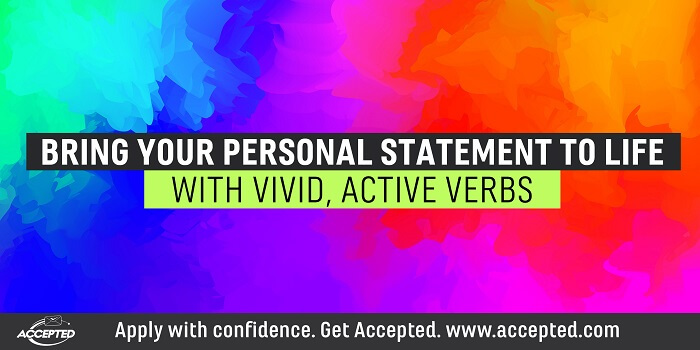
Your personal statement is an essential element of your application and allows the adcom great insight into who you really are aside from your stats. However, no matter how extensive your experience or how accomplished you might be, all that can be lost in prose that does not do a good job of profiling who you are.
A personal statement should be personal. It should narrate an experience that influenced you to become a physician . Sometimes, in an effort to sound professional, applicants can sound instead as though they’re trying too hard, fueled by anxiety or intensity that stems from being competitive. Other times, candidates can sound rote or mechanical, downplaying fabulous achievements by describing them blandly or missing the opportunity to develop the story behind the achievement.
Lastly, some applicants show us a draft of a personal statement that is merely a narrative version of their curriculum vitae. Doing this raises a red flag: the adcom already knows this information. The general rule is to not replicate or reiterate other parts of your application in your personal statement. Instead, tell a human story that exemplifies your ability to be empathetic and compassionate. This requires strong, narrative writing skills that bring to light your beautiful personhood, whether the story you tell is about you or someone else, something you witnessed, and what you have come to understand about humanity, especially disenfranchised populations.
A good personal statement tells a moving story. This writing requires the use of strong, vivid verbs in a way that livens up descriptions. A direct voice is verbally dexterous and precise in vocabulary and descriptive. For example, imagine that you wish to tell the story of having cared for your terminally ill grandmother. Why not develop this idea into a story in which you describe, in detail, what that experience was like. Rather than say, “My grandmother lived with us when she was sick,” try to capture the details: “My grandmother moved into the spare bedroom of our house last January, during a snowstorm so volatile the windows shook.”
In describing an event in time, use active verbs to convey sensory information – images, sounds, smells, tastes, tactile sensations – that will transform your essay into a story your readers will want to continue reading. When you edit your essays, revise your verbs . Evaluate the benefit of replacing humdrum words, those that come to mind automatically, with more succinct and effective words. Choose verbs that feel exactly right rather than approximate.
Did you “try,” “plan,” “strive,” or “struggle” to complete a project?
Use a thesaurus (properly!) to transform your language.
Consult a thesaurus for help in upgrading any bland words. Choosing precise words means that you will likely need fewer adverbs and adjectives. Meanwhile, the revised sentences will be much less general and more succinct and specific. Your writing will gain voice and mood with restored vigor. Be sure to focus on enlivening your writing without overdoing it. Don’t exaggerate, and don’t choose language that sounds melodramatic or sensational. Look up the meaning of synonymous words to ensure that you are using them correctly. Not all synonyms in a word processor’s thesaurus mean exactly the same thing. Consider meaning, connotation, and fluidity. Don’t select certain words simply to impress. Choose them to convey meaning with precision.
Our experienced consultants at Accepted know just how to revise your writing so it reads well to others. We can help balance your vocabulary to ensure that you sound intelligent and authentic. Our application essay services can help you share your story in a manner that presents you meaningfully to others.

Related Resources:
- From Example to Exemplary , a free guide to writing outstanding essays
- First Drafts of Personal Statements: Let Yourself Go
- ‘Twas the Night Before Deadlines: A Cautionary Tale of Cliches
About Us Press Room Contact Us Podcast Accepted Blog Privacy Policy Website Terms of Use Disclaimer Client Terms of Service
Accepted 1171 S. Robertson Blvd. #140 Los Angeles CA 90035 +1 (310) 815-9553 © 2022 Accepted


Want to create or adapt books like this? Learn more about how Pressbooks supports open publishing practices.
18 Professional Speechwriting: Vivid and Sensory Words Make Your Speech Come Alive

“I want pictures in my mind,” I tell my students. “Paint me pictures. Give me word pictures.” The more I can see, feel, taste, and smell what is happening in the speech, the more I am engaged. This chapter is about how to give your students a sensory experience when you speak. It is about using vivid and sensory words to engage the audience. I want to “show” you what this looks like by giving you several quality speeches to experience for yourself.
The tongue can paint what the eyes can’t see. Chinese proverb.
Listen as Will Smith describes jumping out of an airplane. By describing the light colors and what is going on in his mind, we begin to feel his story.
Consider This
Which of these two sentences gets your attention?
The glass shattered into tiny pieces or the glass broke
If you are like most people, the sentence that says the “glass shattered into tiny pieces” captured your attention and caused you to visualize the breaking glass. You might have even thought of the last time you broke a glass. It works because it used vivid language.
Listen as Matthew Dicks explains what it is like to be homeless and taken in by a family that has a pet goat that chews on his hair at night and then he continues to tell his story of being robbed at gunpoint. Notice how you can “see” his story in your mind’s eye.
I n an experiment of investing in the market, researchers tested whether or not language would affect investor judgment. They tested vivid words versus pallid words. In this study, a vivid phrase was “sales jumped. ..analysts viewed this as very impressive” and the pallid phrase was ” sales increased. .analysts view this performance as positive. ” The vivid phrase showed stronger results. In other words, how you tell people to invest can impact the outcome. This is just one of many studies that show the impact of vivid language on thoughts and behaviors.
In other research studies, v ivid messages created greater desirability for the product, caused people to have more favorable beliefs toward an idea and even influenced judgments. Why do they work? Vivid messages work, in part, because they hold our attention.
For vividness to be effective, it must do all the following:
(a) Emotionally interesting. (b) Vivid enough to produce sensations or visual images. (c) Relatable. It must be consistent with the audience’s experiences and knowledge. (d) Related to the central thesis.
At the center of it all, is the audience. The key to making vividness work is audience understanding. For example, A cenote is a pool of water made by a sinkhole that exposes groundwater. This water is usually very clear, very clean, and very cool. Unless you’ve been to a cenote, you may have no idea what a cenote is and therefore would have no idea when a speaker says the lake water was like the cool, clear, water of a cenote. Instead of evoking images, it only produces confusion. Vividness works when the audience can relate, and they can call up the sensations or visual images.
It is also important that the vivid statements relate to the thesis. Researchers Guadagno, Rhoads, and Sagrins tested why sometimes vividness worked and other times it did not. With testing, they found that vivid words persuaded only when the message was strong and the vivid words regarded the central thesis. When vivid information was introduced that did not relate to the main point, it became a distraction. It seems that vividness enhances persuasion, but only when purposefully used, otherwise it is just a distraction that undermines persuasion. Oh yeah, no surprise here, but vividness can’t save a weak argument.
Angelina Jolie Speaks at World Refugee Day
Let’s look at a strong speech that uses vividness.
- Stripped of home and country, refugees are buffeted from every ill wind that blows across this planet.
- They guided me into a small dirt house with no roof to keep out the scorching heat, and they dusted off the two old mats that they ate, slept and prayed on. And we sat and we talked, and they were just the loveliest women. And then with a few twigs and a single tin cup of water, they made the last of their tea and insisted on me to enjoy it.
- He had a dusty face, the brightest green eyes I have ever seen but such a sad look but she explained that he’s always asking for more food. And it hurts her to say that they have nothing. And she asked if we would consider taking him, would we take her sons so he could eat. And she said it with tears in her eyes with such desperation.
- He sat on the dusty floor; he’s been shot on the back and left paralyzed. And he crawled forward to shake my hand, he was no more than fifteen. He had big pretty eyes, big wide sparkling smile, and after all he’d been through, he’s full of laughter and love. Later that night I asked whether he’d not been taken to a hospital or at least given a wheelchair and I was told that the boy’s entire family had been killed so there was no one to look after him.
Angelina Jolie World Refugee Day transcript
After you read this chapter, revisit this speech. While looking at the transcript, try to make a list of all the vivid and sensory words. Categorize them based on the sense they activate.
Use Sensory Words
One type of vividness comes from sensory words. Research demonstrates that we process those words faster than other words. By sensory words, I’m talking about words that have to do with seeing, hearing, tasting, smelling, touching. For just a moment, imagine you are in Paris and you look up to see the top of the Eiffel tower where the structure touches the sky. Chances are, as you thought about this, your eyes went up. You sensed with your body the words that were being spoken. When you hear or read sensory words that you can relate to, your brain lights up. Your brain lights up in the same area that the actual experience would occur–it is as if you are experiencing the word and not just hearing it. When someone talks about the “sweet, gooey cookie pulled out of the oven, and the sweet aroma fills the air and you look down at the partially melted chocolate chips and are eager to take a bite. ” This sentence caused many of you to taste and see the cookie and your brain lights up as if you are eating one. Words that evoke a mental image are the most likely to evoke a sensory image. The more you create “word pictures” that we see in the movie of our minds, the more likely we are to experience it with other senses.
What follows is a chart of the main senses and with examples of the words associated with that sense.
Notice how Brene Brown describes a situation–She has on white slacks and a pink sweater set and how she dropped her coffee on the tile floor, and it splashed on her. She goes on to say that she blamed her husband. She uses it to make a powerful point about blame and accountability and demonstrates for us the power of how vivid descriptions can draw us in and make us want to listen.
Considerations of Using Vividness
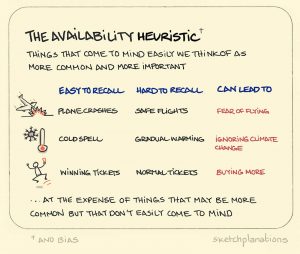
The easier that information is for me to think about, remember, and recall, the more that information influences my decisions. Your goal should be to give the information in such a way that people can process that information. The availability heuristic suggests that when making decisions we tend to base those decisions on things that come to our mind easily. If information is recent, vivid, and fits into our thought patterns, it is more available and therefore is more likely to influence our decision-making.
We are likely to think crime is a threat if there has been a recent break-in in our neighborhood. We are more likely to feel afraid if we watch a lot of crime shows or if there has been a featured news story on assaults. Since that information is recent in our mind and the stories were told to us in a vivid manner, we are more likely to pay attention to that information and then bring it to mind when someone suggests taking a self-defense course.
This collection of motivational stories is powerful because they are real and because in each case, they are told with vividness.
In this next video, the founder of charity water, Scott Harrison tells how he got involved in charity water and what his organization does. Watch this documentary and speech video as he talks about drinking from “scummy swamps.” And how he describes how the women are “breaking their backs to get it.” (You can stop watching at the statistics part –but I warn you it may be hard to stop). What is the point here? The point is for you to notice how he infuses speech, powerful visuals, and vivid words to persuade us to act and to help others to get clean water.
If you watched the video, you saw a worm in the water. Some of you likely had a visceral reaction. For many of you, it caused you to sympathize with the cause, for others, it may have gone too far, and you protected yourself by not watching or by making fun of the video.
If you try to take vividness too far, it can backfire on you. Thoughts that are too uncomfortable, might cause people to suppress the information or deny it altogether. This is particularly true when creating messages that instill fear.
The Extended Parallel Process Model looks at how people respond to messages that create fear as a way to drive positive health outcomes. For example, to get someone to wear a condom, a speaker might activate fear and make them afraid that they will get a sexually transmitted disease. A speaker might share statistics, gruesome stories, and even show slides of infections (flashback to high school health class). The challenge is that people have different reactions to fear-invoking situations–they either minimize their fear–“That’s not going to happen to me, I could tell if my partner has an infection” or they minimize the danger and wear a condom. So what makes the difference?
A speaker who is trying to use research and analogies that produce fear has to find the “sweet spot” in order to get the audience to react in a way that produces a positive health outcome. If the danger feels like it is too much, the listener will just panic or deny the danger. Describing things in too vivid of detail can often backfire and cause people to worry but do nothing or deny that the situation is real.
The goal should be to use just enough vividness that it is memorable and to direct examples towards the specific audience, so they are relatable. Most importantly, fear messages work best when coupled with a specific plan of action. If people feel like there is a do-able way to get rid of the fear, and they are capable of doing it, they are more likely to react.
To recap. For an audience to be impacted, the message has to be relatable. It should be vivid enough to be memorable and activate the senses–but not so vivid that it overwhelms the main message. Vivid descriptions should support the central message. If you are trying to persuade an audience and you use vividness to produce fear, you need to offer them specific, manageable ways to act. Vividness is one more tool in your public speaking toolbelt. Use it wisely!
Key Takeaways
Remember this!
- For vivid words to work they must be emotionally interesting, vivid enough to produce sensations or visual images, relatable to the audience, and related to the central thesis.
- Vivid messages are easier to remember and can be more persuasive.
- When using fear appeals, make sure you could the fear with an action that the audience is capable of performing.
Please share your feedback, suggestions, corrections, and ideas.
I want to hear from you.
Do you have an activity to include? Did you notice a typo that I should correct? Are you planning to use this as a resource and do you want me to know about it? Do you want to tell me something that really helped you?
Click here to share your feedback.
Brown, B. (2015). Brene Brown on blame. [Video]. YouTube. https://www.youtube.com/watch?v=RZWf2_2L2v8&t=31s Standard YouTube License.
Dicks, M. (2016). Live like you are 100 years old. [Video]. YouTube. https://www.youtube.com/watch?v=vnatyrn6DFE Standard YouTube License.
Duncan, K.J. (2021). 583 Sensory words to take your writing from bland to brilliant. https://smartblogger.com/sensory-words/
Goalcast. (2020). Top 5 legendary speeches: Motivation for when life gets hard. [Video]. YouTube. https://www.youtube.com/watch?v=vZ8cuBjoS-w Standard YouTube License.
Guadagno, R, & Rhoads, K. & Sagarin, B. (2011). Figural vividness and persuasion: Capturing the “elusive” vividness effect. Personality & Social Psychology Bulletin, 37, 626-38. doi: 10.1177/0146167211399585
Hales, J., Kuang, X. & Venkataraman, S. (2011) Who believes the hype? An experimental examination of how language affects investor judgments. Journal of Accounting Research, 49 (1), 223-255. https://doi.org/10.1111/j.1475-679X.2010.00394.x
Harrison, S. (2020). The Spring-the charity: water story. [Video]. YouTube. https://www.youtube.com/watch?v=bdBG5V O01e0 Standard YouTube License.
Henneke. How to arouse the magic of sensory words (Even in Business Writing). Enchanting Marketing. https://www.enchantingmarketing.com/sensory-words/
Hey, J. Availability heuristic and bias. Image. Sketchplanations. https://sketchplanations.com/the-availability-heuristic-and-bias
Jolie, A. (2009). Angelia Jolie speak on World Refugee Day 2009. [Video]. YouTube. https://www.youtube.com/watch?v=qtt1Vs9Lcp0 Standard YouTube License.
Juhasz, B. & Yap, M. & Dicke, J. & Taylor, S. & Gullick, M. (2011). Tangible words are recognized faster: The grounding of meaning in sensory and perceptual systems . Quarterly Journal of Experimental Psychology, 64. 1683-91. doi:10.1080/17470218.2011.605150.
Lacey S, Stilla R, Sathian K. (2012). Metaphorically feeling: Comprehending textural metaphors activates somatosensory cortex. Brain Lang, 120(3), 416-21 DOI: 10.1016/j.bandl.2011.12.016
McGili, A. L., & Anand, P. (1989). The effect of vivid attributes on the evaluation of alternatives: The role of differential attention and cognitive elaboration. Journal of Consumer Research, 16( 2), 188-196. https://doi.org/10.1086/209207
Melcher, C. (1999). Provocatively and evocatively vivid language: An extension of language expectancy theory (Order No. 9934847). Available from ProQuest Dissertations & Theses Global. (304495279). Retrieved from https://www.proquest.com/dissertations-theses/provocatively-evocatively-vivid-language/docview/304495279/se-2?accountid=8361
Nisbett, R., & Ross, L. (1980). Human inference: Strategies and shortcomings of social judgment. Prentice-Hall.
Ralston, S. M., & Thameling, C. A. (1988). Effect of vividness of language on information value of reference letters and job applicants’ recommendations. Psychological Reports, 62 (3), 867–870. https://doi.org/10.2466/pr0.1988.62.3.867
Shedler, J., & Manis, M. (1986). C an the availability heuristic explain vividness effects? Journal of Personality and Social Psychology , 51 (1), 26–36. https://doi.org/10.1037/0022-3514.51.1.26
Smith, W (2017). Will Smith on Skydiving. https://www.youtube.com/watch?v=Hpd61o6TvXM Standard YouTube License.
Speakola (2009). Angelina Jolie: ‘I am here today to say that refugees are not numbers,’ World Refugee Day–2009. https://www. speakola.com/ideas/angelina-jolie-world-refugee-day-2009.
Tversky, A. and Kahneman, D. (1974). Judgment under uncertainty: Heuristics and biases. Science , 185 , 1124-1130. https://www.jstor.org/stable/1738360
Witte K, & Allen M. A (2000).meta-analysis of fear appeals: implications for effective public health campaigns. Health Education Behavior. (5):591-615. doi: 10.1177/109019810002700506.
Witte, K. (1992). Putting the fear back into fear appeals: The extended parallel process model. Communication Monographs, 59 (4), 329–349. https://doi.org/10.1080/03637759209376276
Witte, K. (1994). Fear control and danger control: A test of the extended parallel process model (EPPM). Communication Monographs, 61 (2), 113–134. https://doi.org/10.1080/03637759409376328
Media Attributions
- rhondak-native-florida-folk-artist-_Yc7OtfFn-0-unsplash © RhondaK Native Florida Folk Artist is licensed under a CC0 (Creative Commons Zero) license
- The Availability Heuristic © Jono Hey is licensed under a CC BY (Attribution) license
Advanced Public Speaking Copyright © 2021 by Lynn Meade is licensed under a Creative Commons Attribution-NonCommercial 4.0 International License , except where otherwise noted.
Share This Book

IMAGES
VIDEO
COMMENTS
Writing vivid descriptions involves using specific language to help your own writing stand out and form a detailed mental picture for readers. Whether it's for a novel, formal essay, short story, or public speaking event, it's important to make sure your writing is memorable and interesting for your audience. Writing vivid descriptions ...
Techniques for Incorporating Vivid Language in Your Essays 1. Using Descriptive Adjectives and Adverbs. When it comes to painting a vivid picture with words, adjectives and adverbs are your best friends. Instead of using generic terms, opt for specific and evocative descriptors that appeal to the senses.
Example 2: "The Bustle of the City Market". Essay Excerpt: "The city market was a mosaic of sounds and sights, a tapestry of life in motion. Stalls adorned with vibrant fruits and vegetables ...
Descriptive essays breathe life into words by painting a vivid picture of a person, place, thing, or experience. They employ sensory details and expressive language to make the subject come alive for the reader. Here's a basic yet effective structure you might use when crafting a descriptive essay: 1. Introduction.
The New Oxford Dictionary defines vivid as "producing powerful feelings or strong, clear images in the mind.". The key word is "clear.". We want to strive for clarity with our verbs. Take the verb "fall" as an example. There's nothing wrong with the word; most people know what it means.
Descriptive essay example. An example of a short descriptive essay, written in response to the prompt "Describe a place you love to spend time in," is shown below. Hover over different parts of the text to see how a descriptive essay works. On Sunday afternoons I like to spend my time in the garden behind my house.
Read on for six ways to produce vivid descriptions with examples, ranging from the use of the five senses to word choice. 1. Use the Five Senses. The easiest way to infuse vivid descriptions into your writing is to describe what your character experiences through their five senses (sight, smell, hearing, touch, taste).
6. Use Vivid Verbs. Selecting strong and vibrant verbs can bring your descriptions to life by portraying actions with precision and impact. Instead of using generic verbs like \"walk\" or \"run,\" opt for more vivid alternatives such as \"saunter\" or \"dart.\". By utilizing descriptive verbs, you add depth to your writing and ...
inconsistency in your essay. • suggests an answer complex enough to require a whole essay's worth of discussion. If the question is too vague, it won't suggest a line of argument. The question should elicit reflection and argument rather than summary or description. • can be explored using the sources you have available for the assignment,
To write a standout essay, you can use literary devices to pull the reader in and catch their attention. Literary devices often complement each other and can be woven together to craft an original, vivid, and creative personal essay. However, don't overdo it; focus on using just a few devices well, rather than trying to use as many as possible.
Be the first to add your personal experience. 5. Use point of view and voice. Be the first to add your personal experience. 6. Use revision and feedback. 7. Here's what else to consider. Writing ...
Use the active voice. Concise, active words in your descriptive writing can make it more vivid. By starting with your subject, it infuses your sentences with action, creating activity and interest in your key message. Starting with the action can be exciting and invigorating to audiences, and keep them paying attention.
What are vivid verbs? "Vivid verbs" are active words that convey a clear, concise, and evocative action to the reader, and that are strong enough to stand alone without additional adverbs or description. For example, "shuffle" and "saunter" are two vivid verbs that describe the act of walking, each with different connotations and ...
It is advice on how to break free of cliche approaches to painting, but it applies almost just as well to writing. The first step to vividly describing a place, person, or thing is to imagine it in your mind's eye. Alternately, if it actually exists you may prefer to look at it or a photograph directly. Either way, you'll start with some ...
Introduction. Writing is a series of choices. As you work on a paper, you choose your topic, your approach, your sources, and your thesis; when it's time to write, you have to choose the words you will use to express your ideas and decide how you will arrange those words into sentences and paragraphs.
Remember, practice makes perfect, and in the case of descriptive essays, practice makes vivid! 3. Apply Sensory Words. Now that you've got your vocabulary toolbox ready, it's time to dive into the core of descriptive writing. Which type of essay relies on sensory and feeling words? You guessed it - a descriptive essay. Using sensory words is ...
Walk — schlepp, hit the road, wend their way. Eat — chow down, pig out, polish off. Get — snap up, come by, wangle. Make — dream up, dash off, throw together. Tell — let slip, keep posted, clue in. Tip: When you're looking out for boring verbs, watch out for passive verbs too: they weaken your writing.
Descriptive writing is an art that allows readers to mentally experience a scene or person through words. By using sensory details and figurative language, writers can create vivid imagery in the reader's mind. This article will provide you with a descriptive writing prompt to practice painting pictures with words. So, grab your pen and let your imagination run wild!
Concise language: Using the fewest possible words without sacrificing meaning makes your writing more understandable. Especially avoid unnecessary use of the verb "to be" when it contributes to nominalizations and expletives. Precise language. Never sacrifice clarity to novelty. This sometimes occurs when student writers work with a thesaurus ...
A good personal statement tells a moving story. This writing requires the use of strong, vivid verbs in a way that livens up descriptions. A direct voice is verbally dexterous and precise in vocabulary and descriptive. For example, imagine that you wish to tell the story of having cared for your terminally ill grandmother.
Write an essay using vivid words Write a composition of three to four paragraphs (at least 200 words) making use of what you have learned about vivid adjectives and adverbs. Choose an event to discuss, describing it as accurately as possible, or make up an imaginative story.
Writing with Vivid Words. Writers engage their readers by using colorful details to describe the world around them. Give your students practice writing with detail. As they use vivid words to tap into all five senses, they are sure to elevate their writing style! Download Free Worksheet. Add to collection.
They tested vivid words versus pallid words. In this study, a vivid phrase was "sales jumped...analysts viewed this as very impressive" and the pallid phrase was " sales increased..analysts view this performance as positive. " The vivid phrase showed stronger results. In other words, how you tell people to invest can impact the outcome.